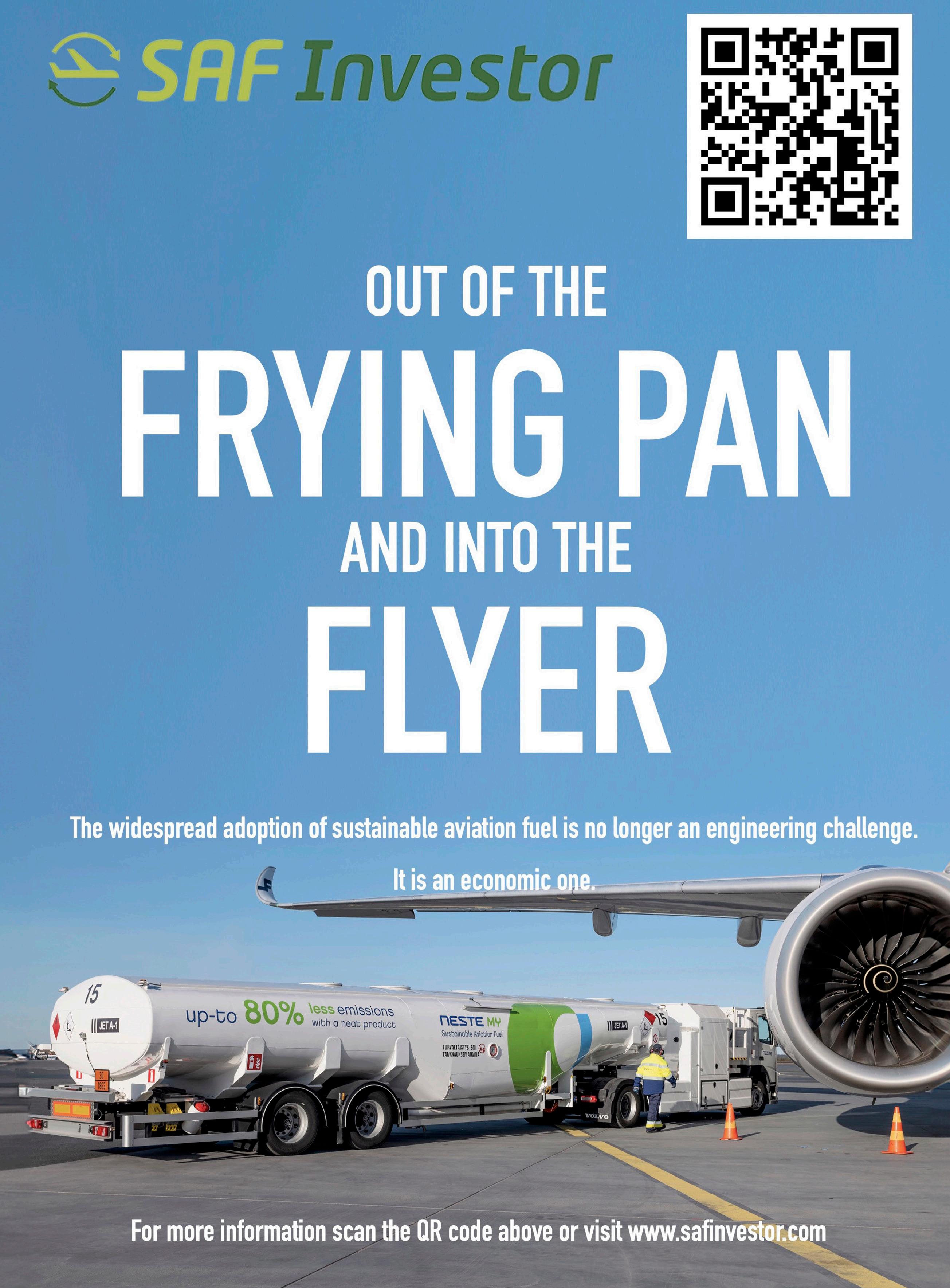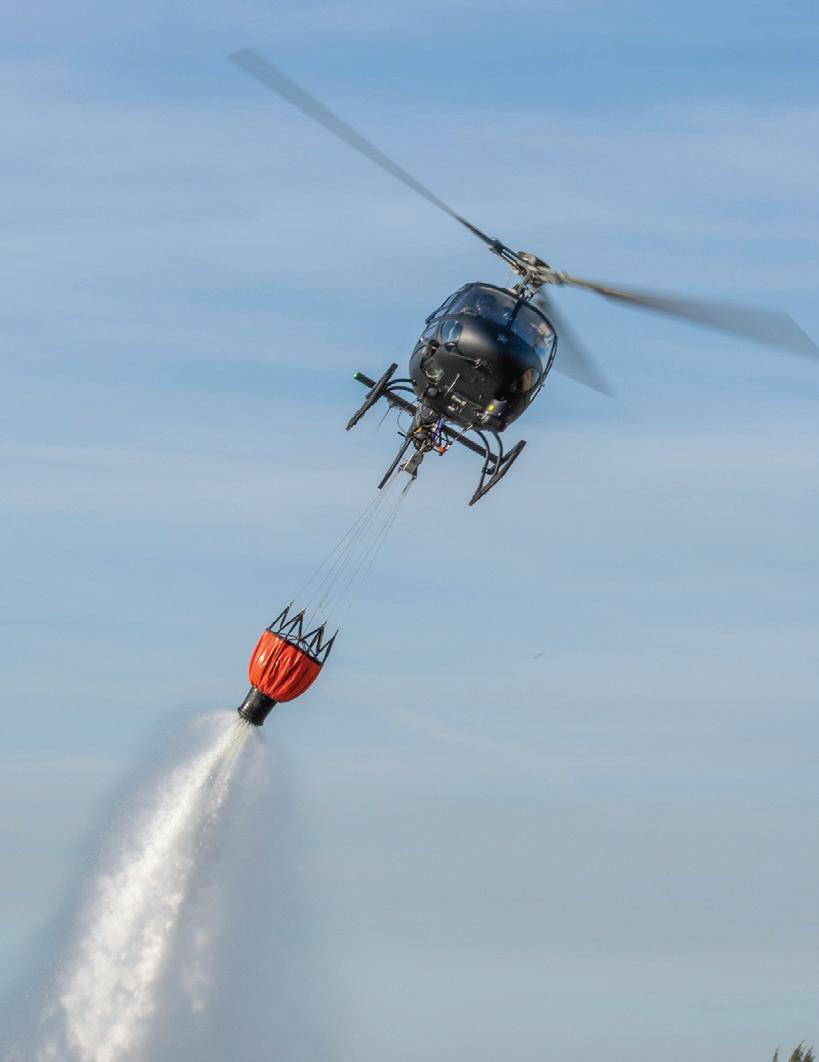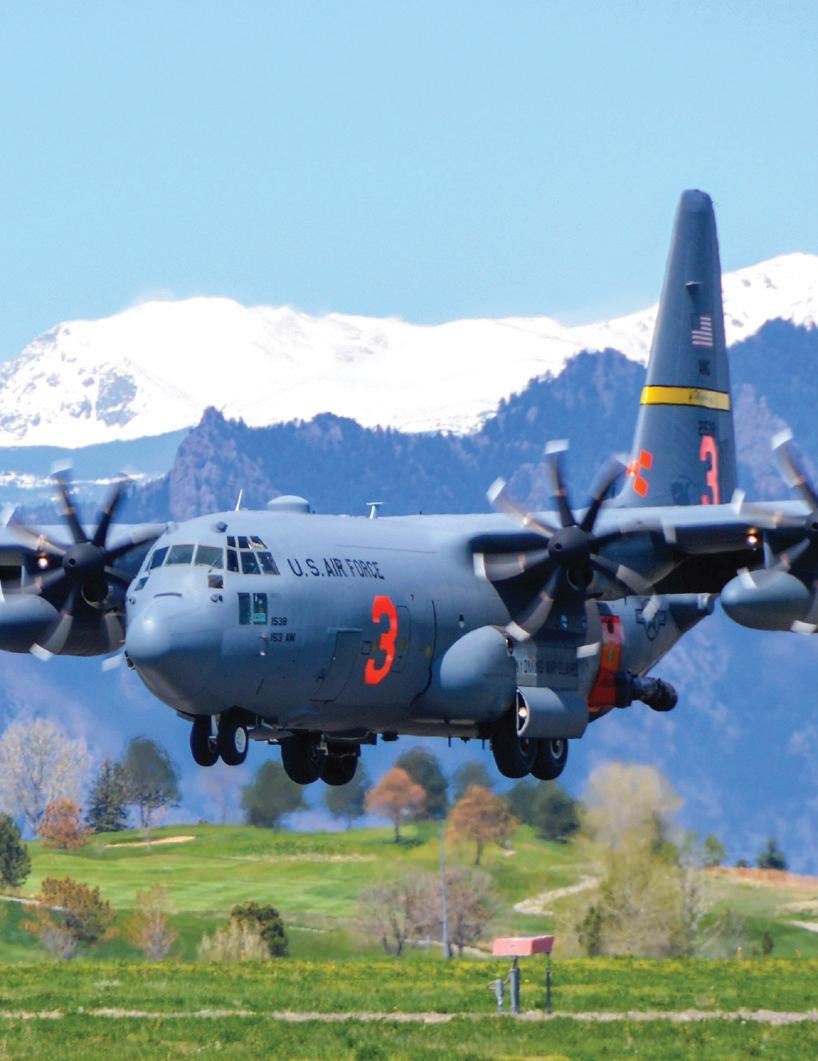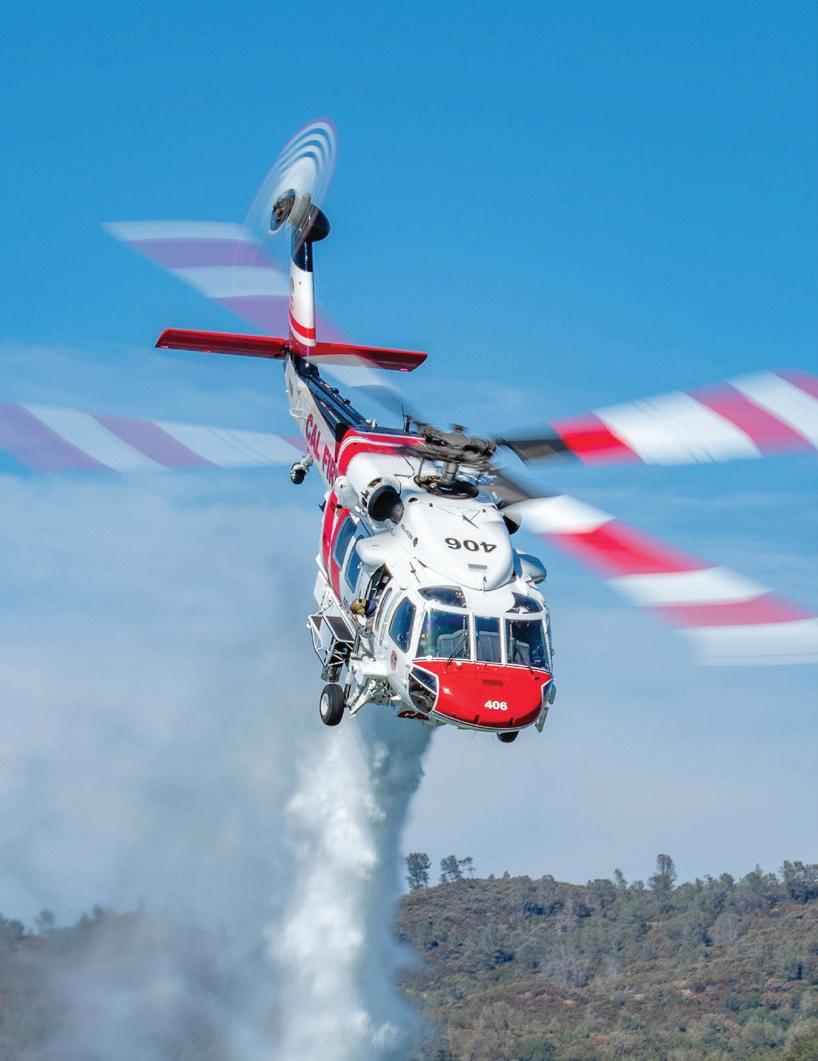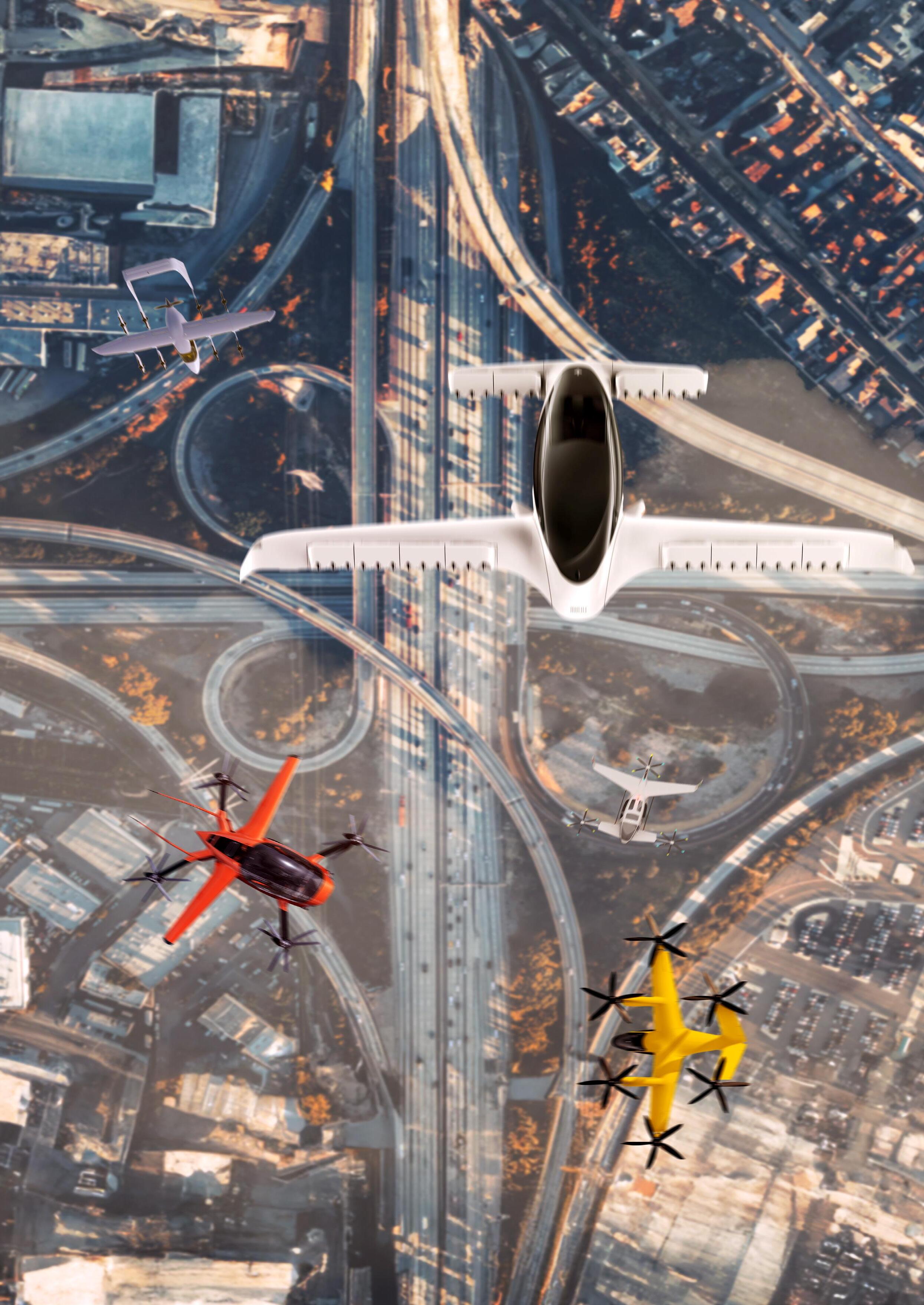
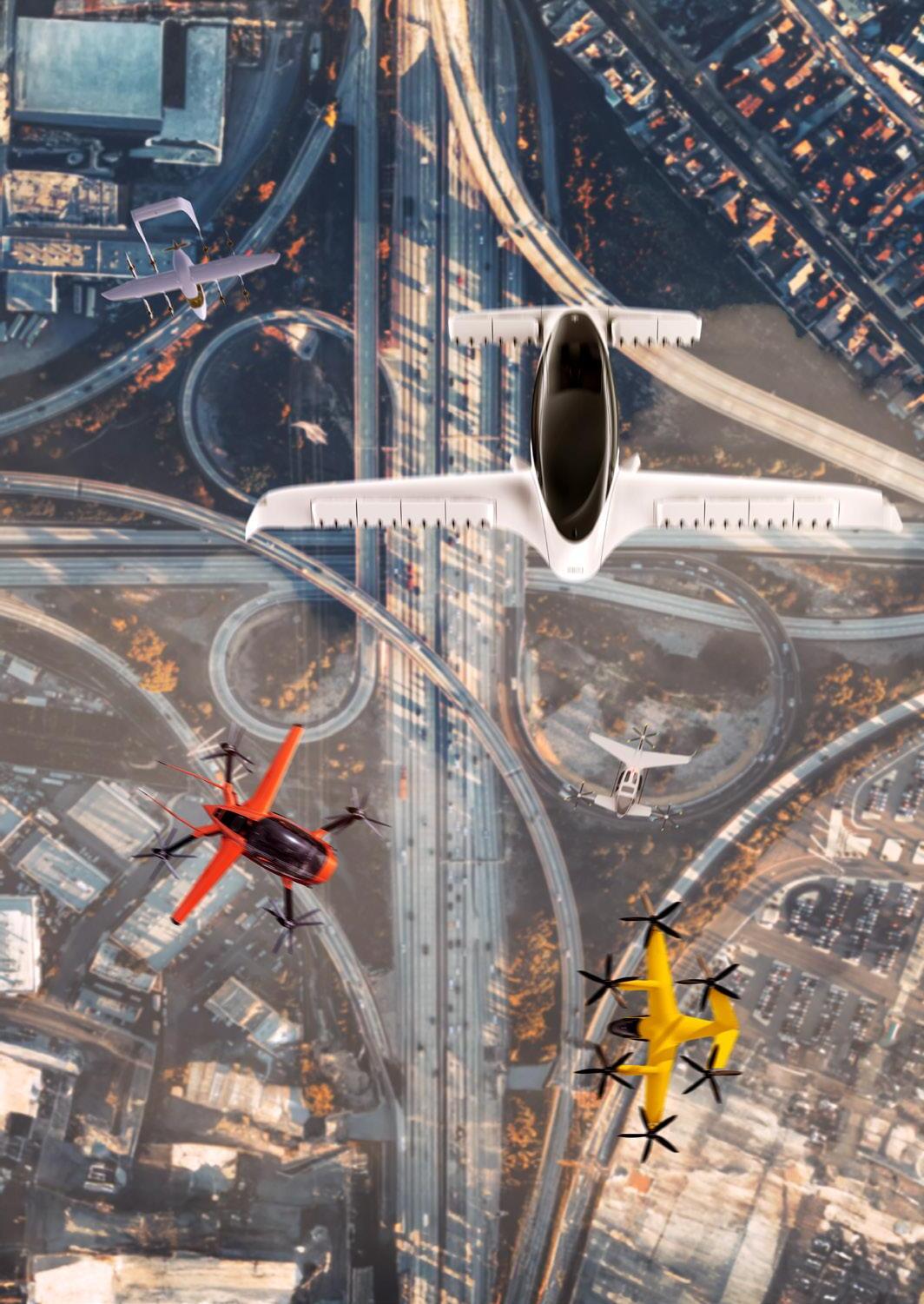

PUBLISHER
Sacha Wetzel
EDITOR IN CHIEF
Jason Jorgensen
DESIGN LEAD
Gustavo Bello
RESEARCH LEAD
Bhaskar Bhuyan




PUBLISHER
Sacha Wetzel
EDITOR IN CHIEF
Jason Jorgensen
DESIGN LEAD
Gustavo Bello
RESEARCH LEAD
Bhaskar Bhuyan
As spring breathes new life into our world, so too does it invigorate our industry with remarkable progress and pioneering initiatives.
This month, sustainable aviation soars to new heights with groundbreaking advancements in electric propulsion and hydrogen fuel technology. Major airlines and startups alike are unveiling their latest eco-friendly aircraft designs, promising a greener future for air travel.
Advanced air mobility is on the brink of transformation. Urban air taxis are no longer a distant dream, with pilot programs launching in key cities worldwide. The promise of congestion-free commutes is closer than ever, thanks to these cutting-edge eVTOL (electric vertical takeoff and landing) vehicles.
The helicopter sector is also evolving to provide further innovations which are enhancing efficiency and safety, ensuring that helicopters remain indispensable in emergency response and urban transport.
Drones continue to redefine logistics and surveillance, with regulatory bodies gradually adapting to integrate these versatile UAVs into our airspace. From medical supply deliveries in remote areas to precision agriculture, drones are proving their worth in countless applications.
In business aviation, the focus has been on sustainable luxury. High-net-worth individuals and corporate leaders are prioritizing ecofriendly options without compromising on comfort and performance. The latest business jets boast impressive range and efficiency, underscoring the industry's commitment to reducing its carbon footprint.
As we chart the course for the future, Avfoil Chronicles remains dedicated to highlighting the news of innovative strides and challenges faced by these sectors as we embrace the skies of tomorrow with a shared vision for sustainability and progress today.
-Jason
AVFOIL NEWS CHRONICLES is published monthly by:
AVFOIL LIMITED
4 Mustang Lane, Wanaka Airport, Wanaka 9382, Otago, New Zealand news@avfoil.com • avfoil.com
Publisher: Sacha Wetzel - sacha@avfoil.com
EDITOR IN CHIEF: Jason Jorgensen - jason@avfoil.com
© Copyright 2024
AVFOIL NEWS CHRONICLES retains all rights for reproduction of any material submitted, to include but not limited to articles, photographs, emails and bulletin board posts. All material remains the copyright of AVFOIL NEWS CHRONICLES. No part of this publication may be reproduced, in part or whole, without the written consent of the publisher. Published content does not necessary reflect the views of the publisher. Content within AVFOIL NEWS CHRONICLES is believed to be true and accurate and the publisher does not assume responsibility for any errors or omissions. Unsolicited editorial manuscripts and photos are welcomed and encouraged. We cannot be responsible for return unless submissions are accompanied by a stamped, self-addressed envelope. Advertising deadline is 12 noon, on the 1st of the month preceding the month of publication.


Helicopter Press Release Recoil Aerospace Group
Fixed-Wing Press Release IPT Aero
Future Flight Chris Stonor eVTOL Insights
UAS / UAV Yves le Marquand Revolution.Aero
Sustainability Fayaz Hussain SAF Investor


Helicopter Press Release Airbus
Fixed-Wing Yves le Marquand Corporate Jet Investor
Future Flight Yves le Marquand Revolution.Aero
UAS / UAV Press Release Skyfire Consulting
Sustainability Fayaz Hussain SAF Investor
Helicopter Press Release LifeFlight Australia
Fixed-Wing Press Release Moonware
Future Flight Chris Stonor eVTOL Insights





UAS / UAV Chris Stonor eVTOL Insights
Sustainability Fayaz Hussain SAF Investor
Helicopter Press Release Robinson Helicopters
Fixed-Wing Press Release AirSuite
Future Flight Chris Stonor eVTOL Insights
UAS / UAV Press Release ANRA Technologies
Sustainability Chris Stonor eVTOL Insights

Helicopter Press Release Kaman
Fixed-Wing Mike Stones
Future Flight Yves le Marquand
Jet Investor
UAS / UAV Chris Stonor eVTOL Insights
Sustainability Fayaz Hussain
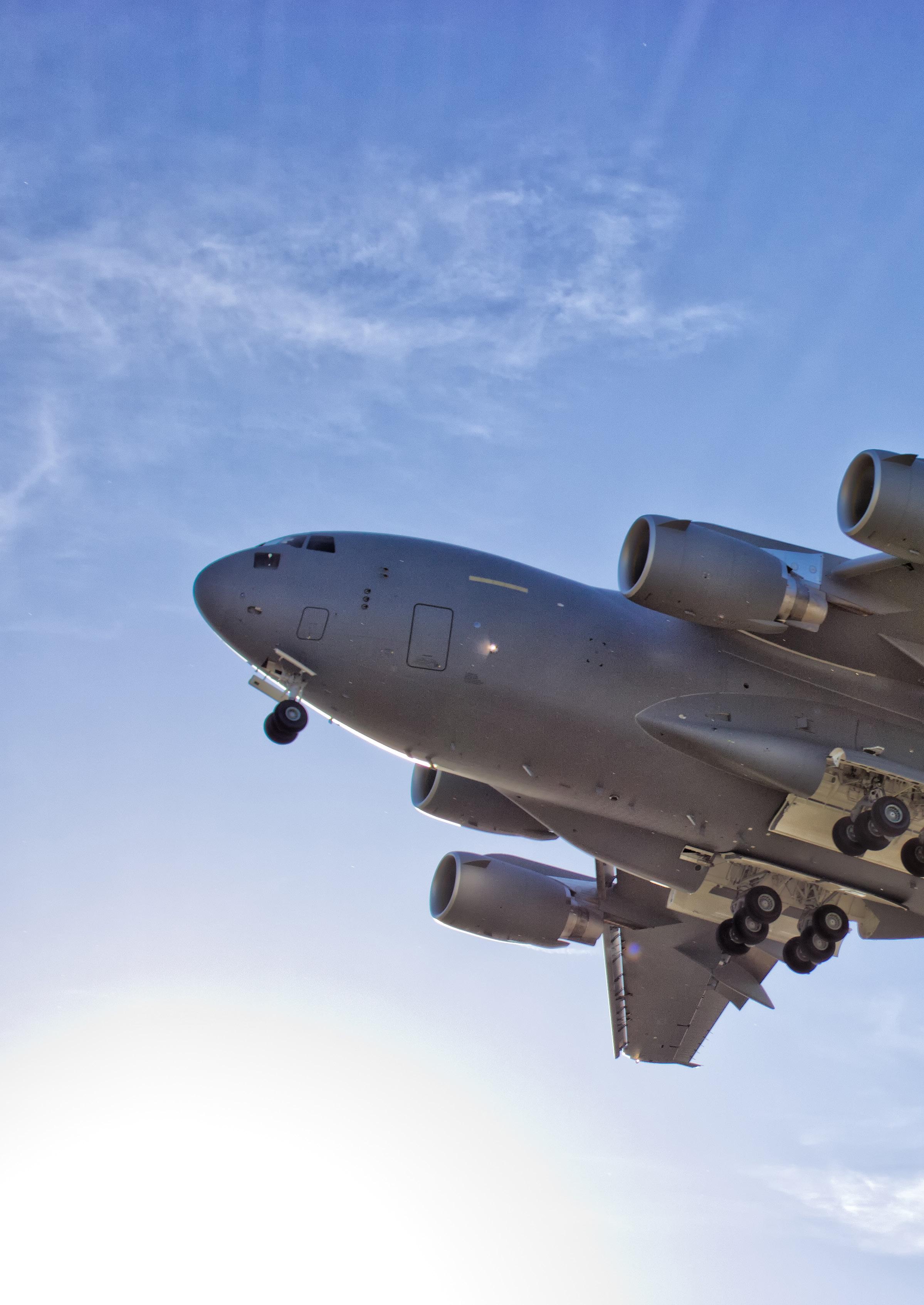
Tag us in your aviation related photos for a chance to to be featured in our next issue!
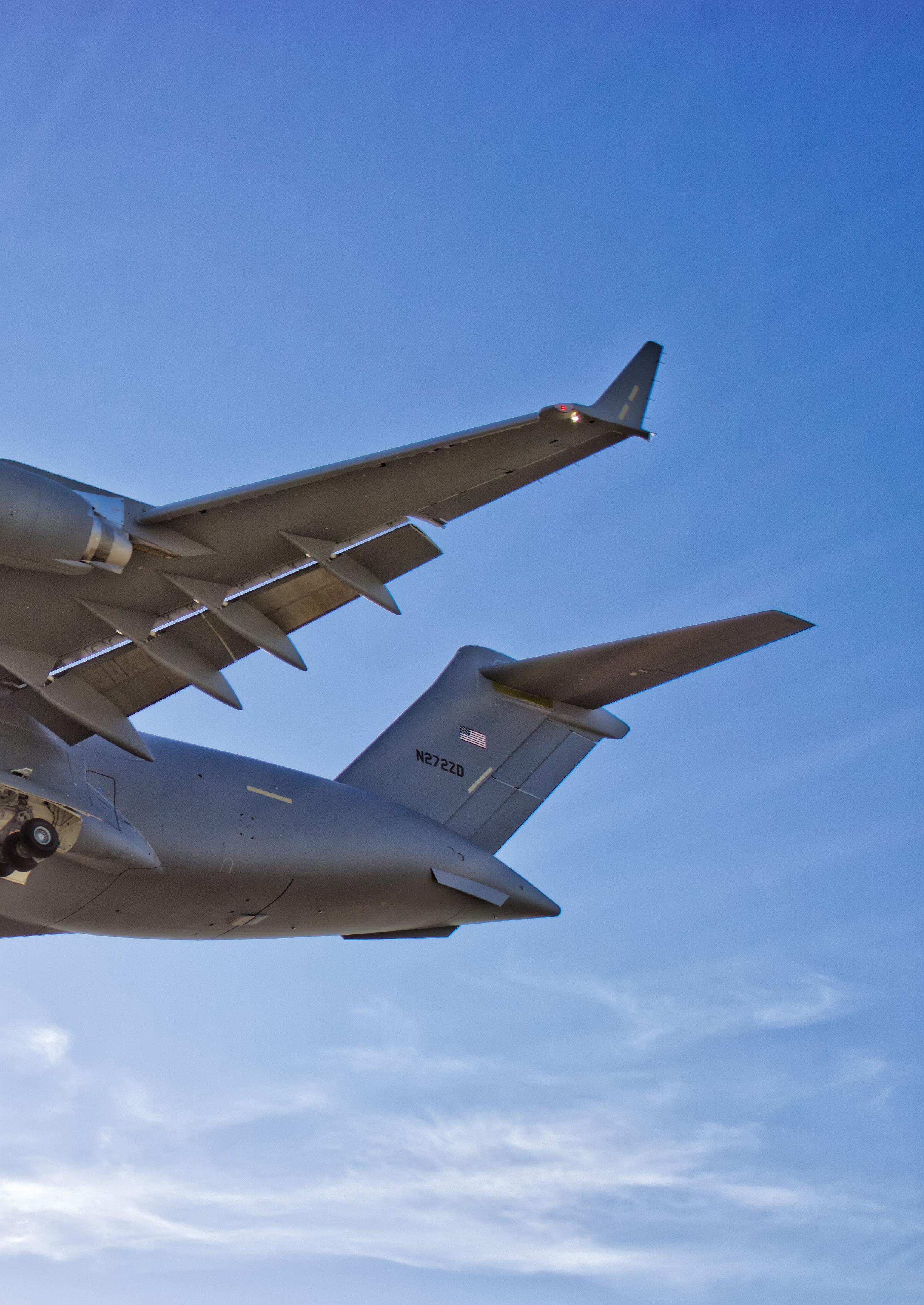



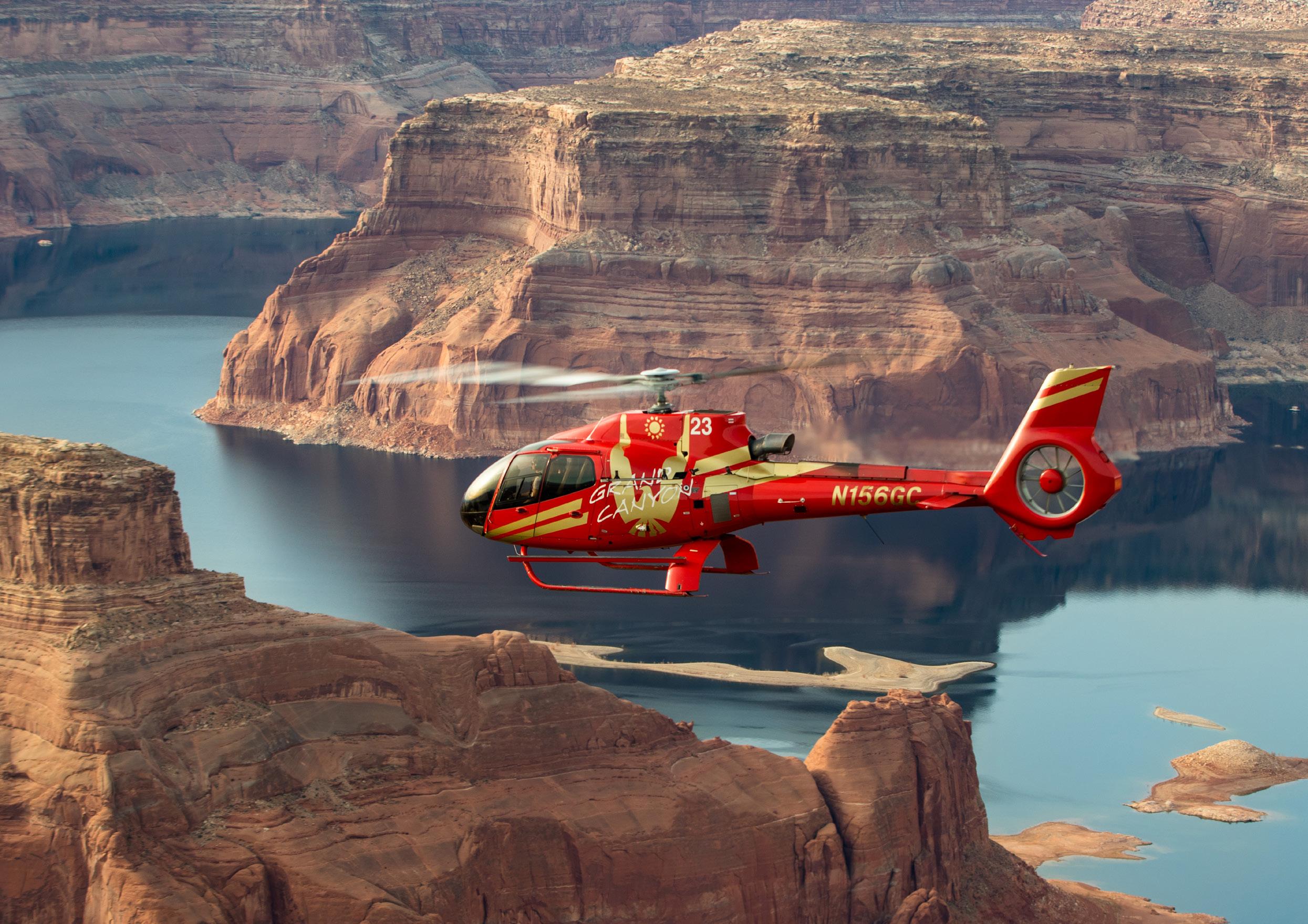

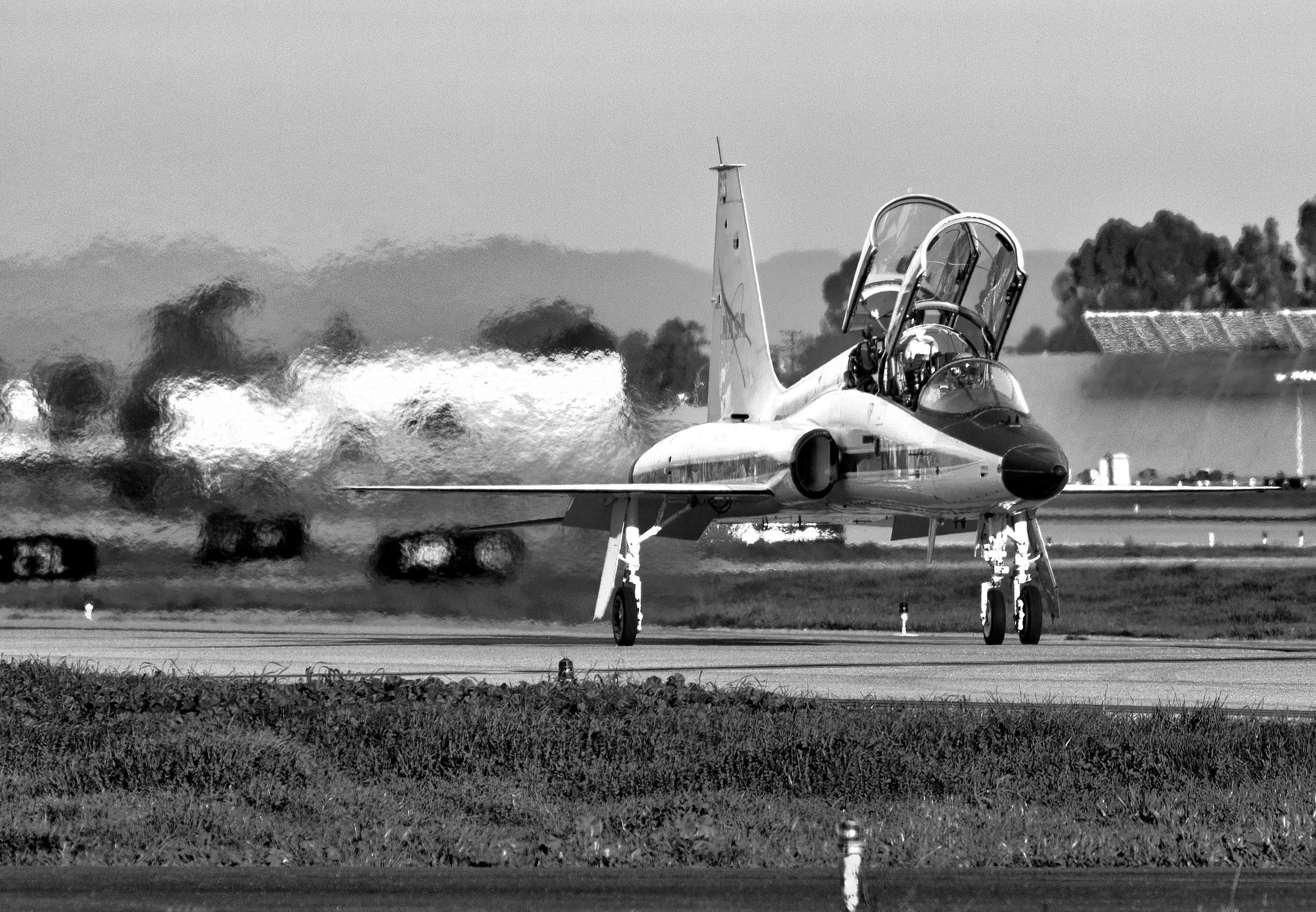

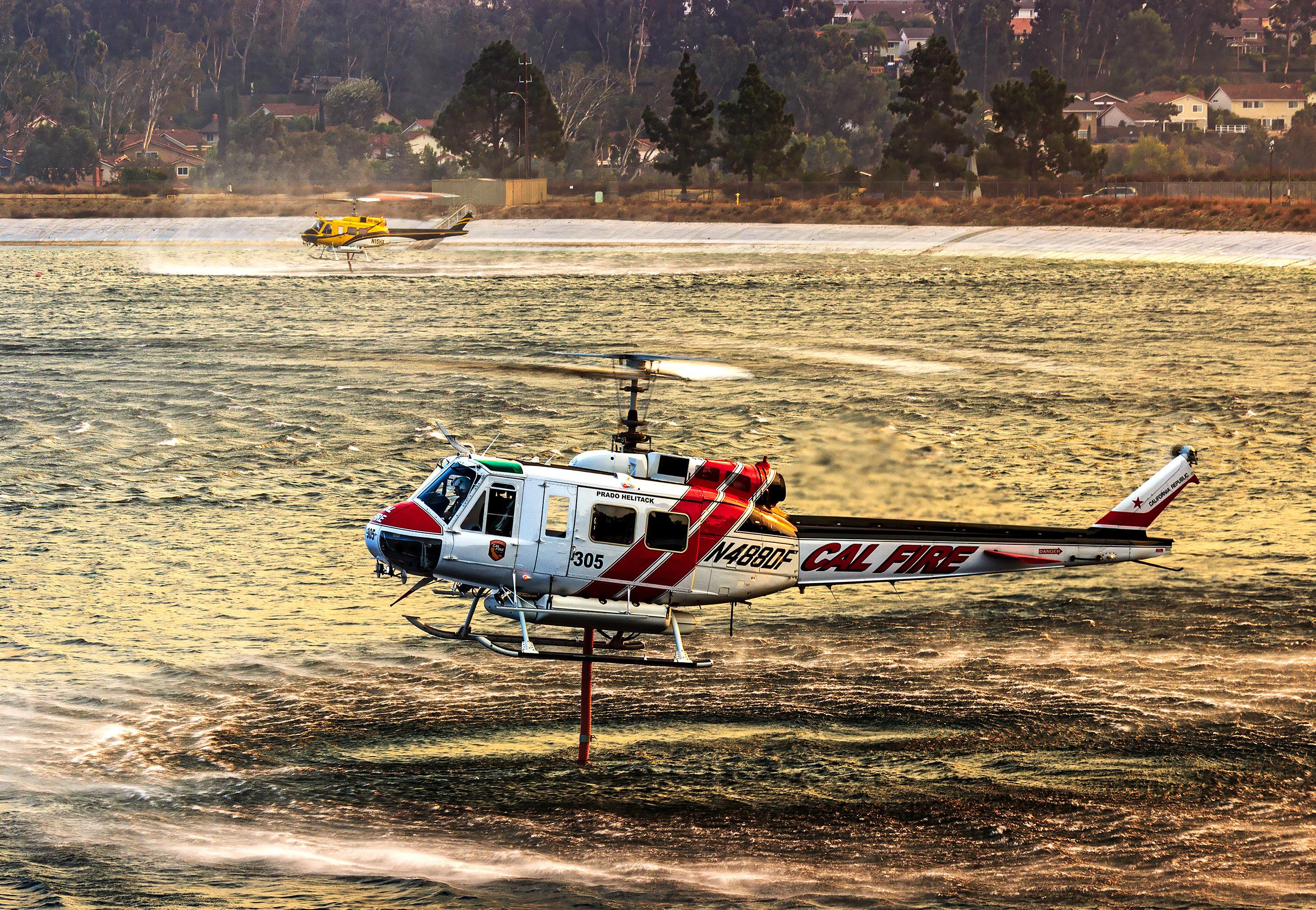
Source: Recoil Aerospace Press Release
Recoil Aerospace has announced the successful certification of its T1000-E Aerial Fire Suppression System (AFSS) by the Federal Aviation Administration (FAA) for installation on Airbus Super Puma series helicopters.
This achievement marks a significant milestone in aerial firefighting technology, positioning Recoil as a leader in innovative solutions for combating wildfires.
“We are confident that the T1000-E will set a new standard in aerial firefighting,” said Joseph Rice, president of Recoil Aerospace. “With its innovative features and enhanced capabilities, the T1000-E provides firefighters with a powerful tool to combat wildfires and protect communities.”
The T1000-E is a 3,785-liter (1,000-gallon) lightweight carbon fiber retractable externally mounted wildfire suppression tank, offering rapid filling (35 to 40 seconds) and fast drops (five seconds).
An integrated 132-liter (35-gallon) foam tank enhances firefighting capabilities, while pneumatic drop valves and computer-controlled operation ensure precision. LED pulse lights, flood lights, and IR lights guarantee optimal visibility during day and night operations, including NVG use.
For ground crew safety, a hailing siren is included. Powered by the aircraft’s AC/DC system, the T1000-E boasts an industry-first optional Heads-Up Display (HUD) for pilots, promoting situational awareness and increasing safety.
Recoil Aerospace extends its gratitude to its T1000-E Super Puma launch customers:
• Heli-Austria (Europe)
• Coldstream Helicopters (Canada)
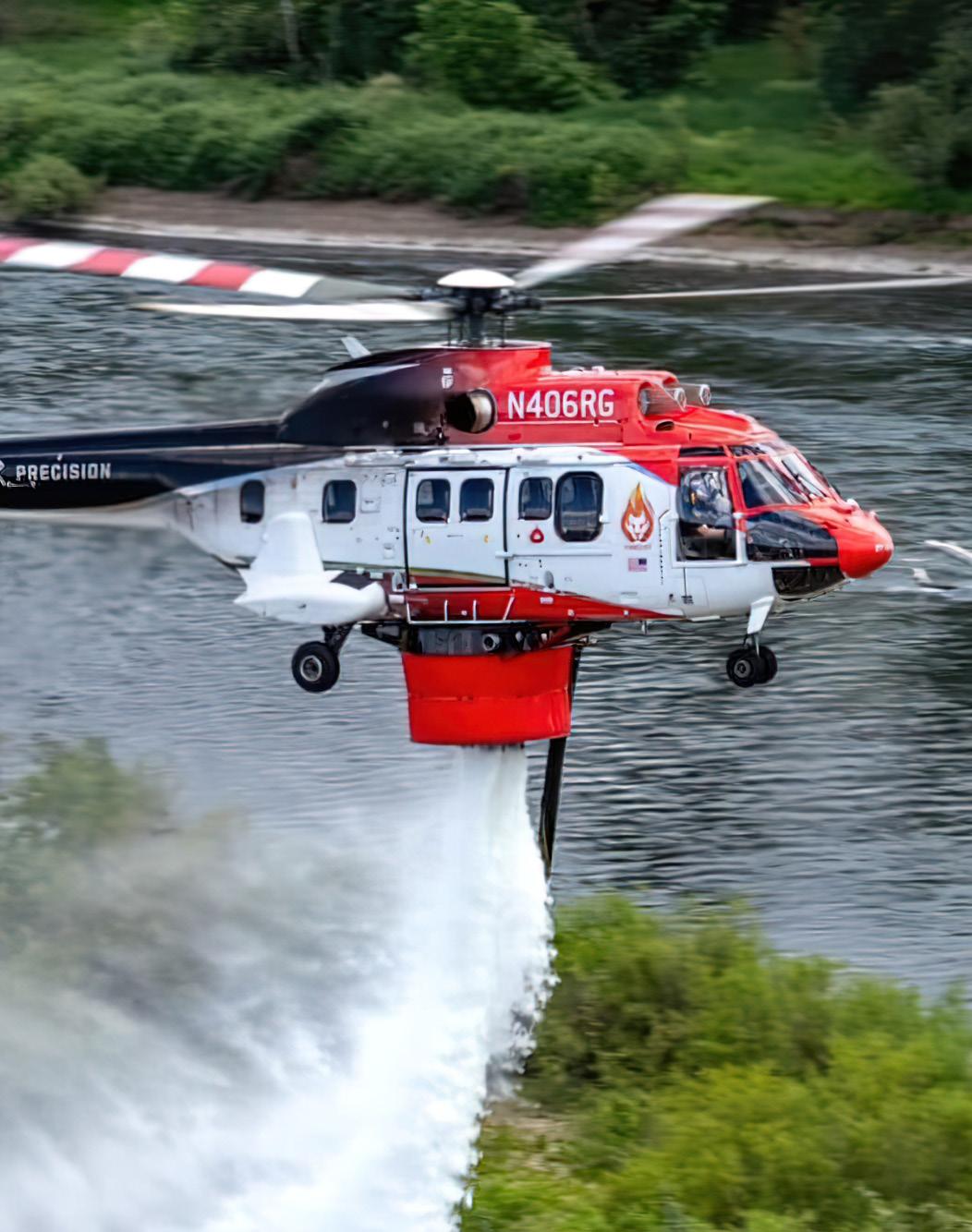
• Precision (United States)

• Korean 119 Rescue Services (Asia Pacific)
The SR02584AK FAA Approved Manufacturer Listing Supplemental Type Certificate (AML STC) paves the way for broader adoption.
The Sikosrky UH-60 Blackhawk is currently undergoing the certification process, with completion slated for early Q4 2024. Recoil has set its sights on adding certifications for the Sikorsky S-92 and S-76, Bell 205 Series, and Leonardo AW189 helicopter models in 2025.
Additionally, bilateral STC recognition with Transport Canada Civil Aviation (TCCA) and the European Union Aviation Safety Agency (EASA) is underway.
Source: Airbus Press Release
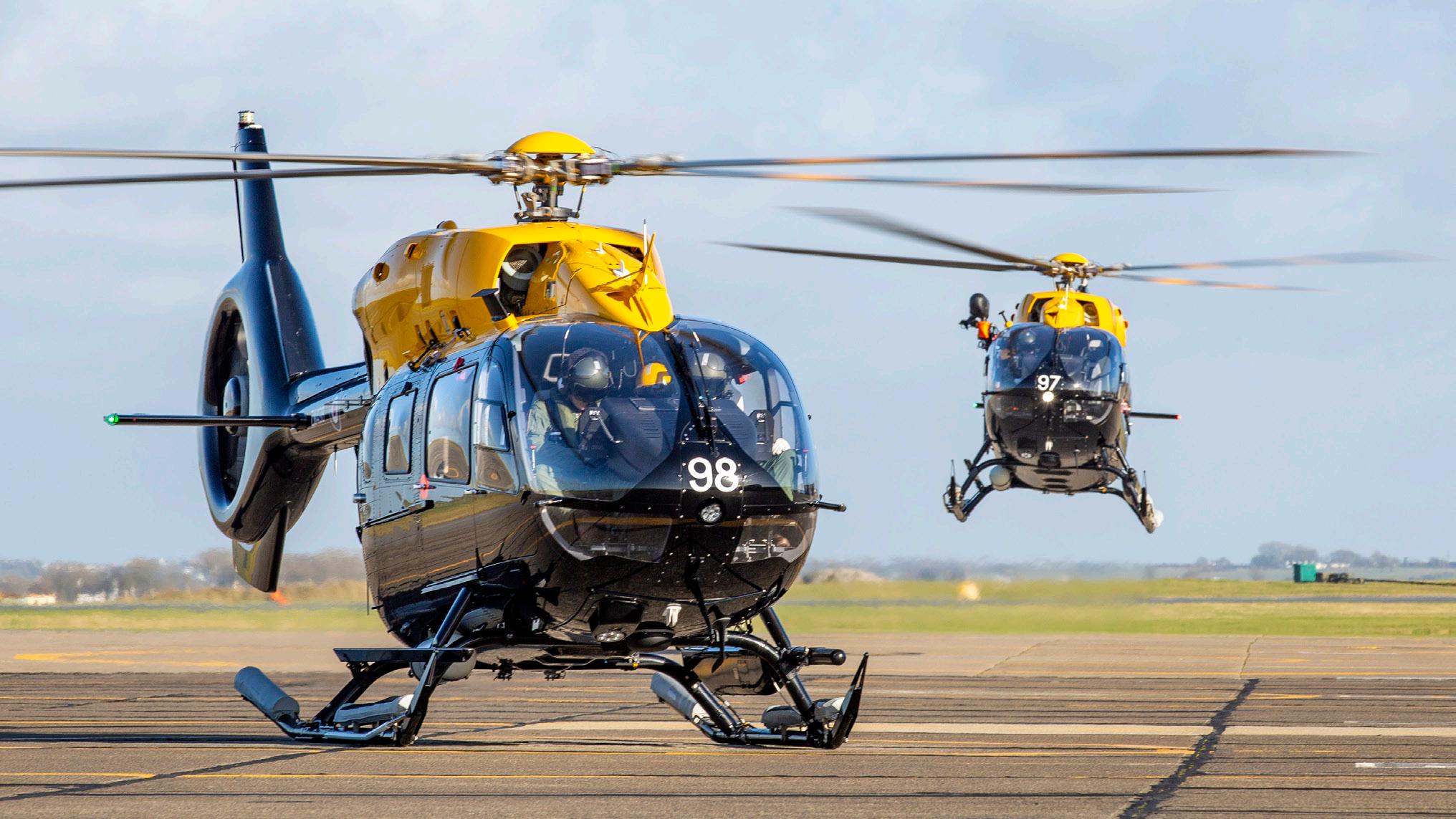
TheU.K. Ministry of Defence has ordered a further six Airbus H145 helicopters as the next step in renewing its rotary fleet and cutting the number of different types in service.
The new aircraft will be deployed to Cyprus primarily for emergency response duties and to Brunei to support UK military training in jungle warfare and will replace Airbus Pumas currently performing those roles.
Airbus Helicopters in the U.K. Managing Director Lenny Brown said: “We congratulate the MoD on this smart acquisition which simultaneously provides the right-sized helicopter for the Cyprus and Brunei requirements, represents excellent value for the U.K. taxpayer, and is another key step in the rationalisation of types in the transport helicopter fleet.”
“The H145 Jupiter, and its sister H135 Juno, continue to demonstrate exceptional reliability and versatility in the training role in the Military Flying Training System (MFTS) and will bring these crucial attributes to their new tasks.”
The new helicopters will be delivered next year and will serve in parallel with 29 H135s and seven H145s in the Defence Helicopter Flying School which trains all U.K. military pilots as

part of MFTS at RAF Shawbury. The enlarged H145 fleet brings economies of support costs and substantially reduces pilot conversion training time.
The latest version of Airbus’ best-selling H145 adds an innovative five-bladed rotor to the multi-mission H145, increasing the useful load of the helicopter by 150 kilograms.
The simplicity of the new bearingless main rotor design eases maintenance operations, improves serviceability and reliability, and enhances flight comfort for both passengers and crew.
Worldwide there are more than 1,675 H145 family helicopters in service, with a total of more than 7.6 million flight hours. Powered by two Safran Arriel 2E engines, the H145 is equipped with a full authority digital engine control (FADEC) and the Helionix digital avionics suite. It includes a high performance four-axis autopilot, increasing safety and reducing pilot workload.
The Helionix avionics generate significant savings in pilot training due to commonality between different Airbus types including the H135 and H175M.
LifeFlight and RACQ close chapter on 30-year partnership
Source: LifeFlight Australia Press Release
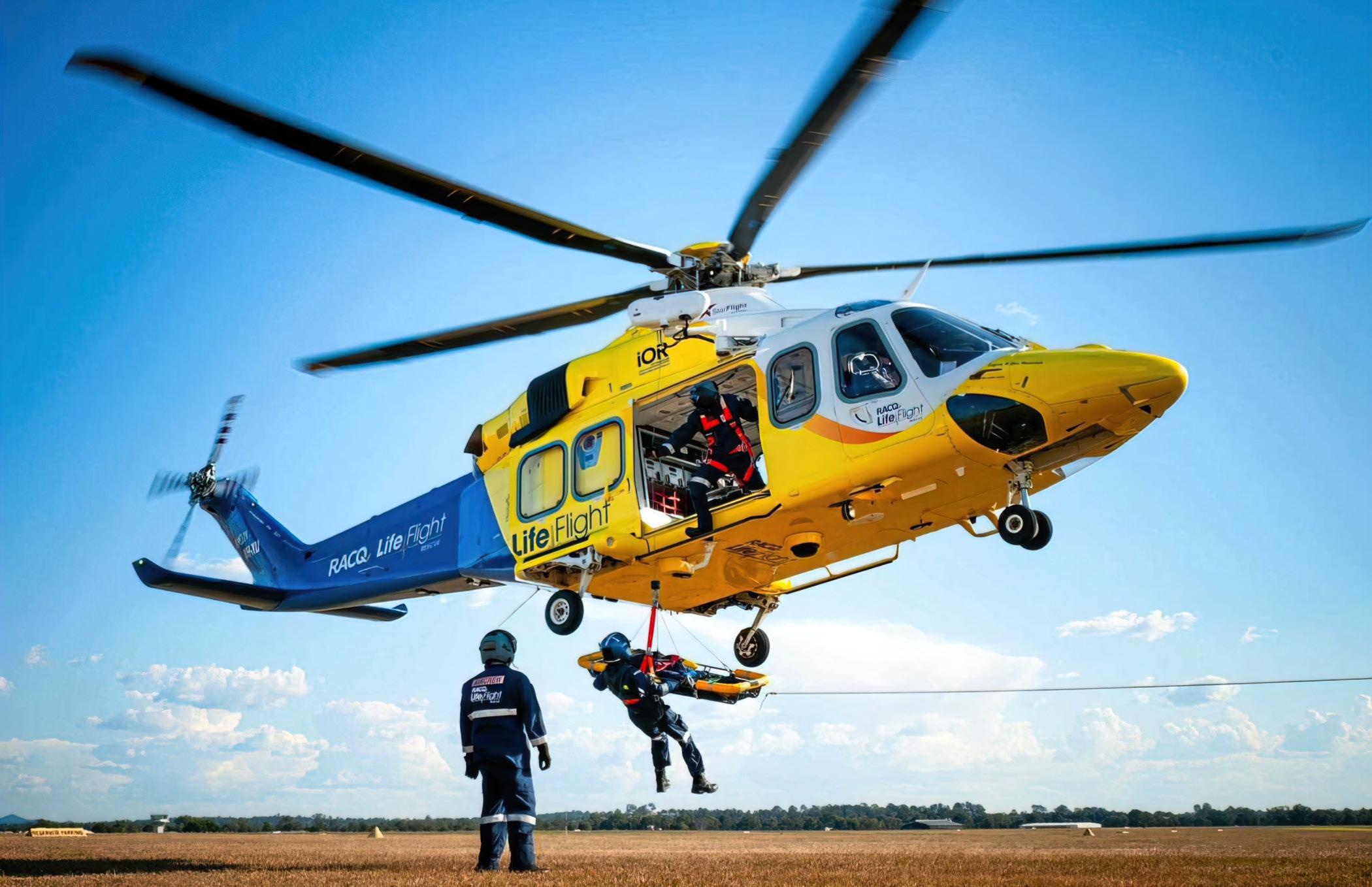
Australia CEO, Ashley van de Velde OAM, has thanked RACQ for its dedication to the network over the past 30 years.
The RACQ naming rights sponsorship of LifeFlight Rescue will come to an end on June 30 after the State Government last year announced additional 10-year funding of $586.1 million to LifeFlight’s rescue service.
RACQ has helped fund and been the proud sponsor of the vital rescue and aeromedical helicopter service, creating Queensland’s longest corporate partnership.
“We are incredibly grateful to RACQ for its unwavering support and a shared commitment to save lives,” van de Velde said.
“The partnership with RACQ has enabled LifeFlight to help more than 81,000 people.
“It’s an incredible milestone few companies can claim and is testament to the strength, leadership and dedication of two leading Queensland organizations to support communities 24/7 and



provide outstanding aeromedical care.


“While it’s the end of an era as our naming rights sponsor, we are continuing to explore new partnership opportunities with RACQ which could see continued investment and support for Queensland communities.”
RACQ Group CEO David Carter said he was proud of the incredible legacy RACQ had built with the life-saving organization.
“RACQ and LifeFlight have always shared a vision and commitment to help Queenslanders in times of need by ensuring access to the very best medical service,” Carter said.
“We remain just as proud today as we were all those years ago to have our brand associated with such a purpose-driven cause which makes a vital difference to the lives of many Queenslanders.
“Since 2010, RACQ has provided more than $50 million in sponsorship and donations to LifeFlight Rescue, with the critical service responding to thousands of missions.”
Source: Robinson Helicopter Company Press Release
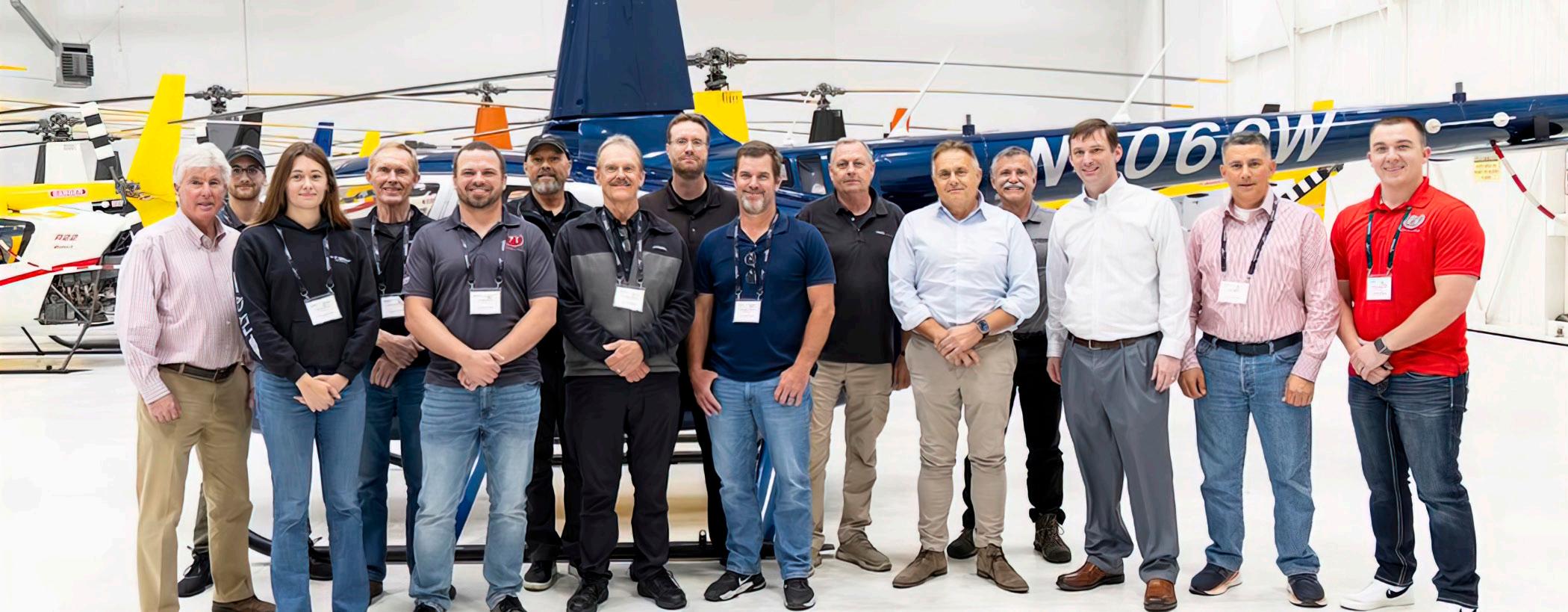
Robinson Helicopter Company (RHC) has announced its new Instructor Pilot (IP) Standardization Course.
This comprehensive program elevates helicopter flight training by equipping instructors with the skills and knowledge to produce highly proficient pilots.
Leveraging decades of safety expertise, the new IP course builds upon RHC’s well-established Safety Course, a cornerstone program for more than 40 years. This enhanced curriculum signifies a strategic shift, positioning Robinson as a preeminent leader in safety and global helicopter pilot training.
The Robinson IP program offers graduates the opportunity to join a network of “approved training providers.” This designation signifies instructor qualification and provides new opportunities for aspiring operators and pilots.
Furthermore, as RHC expands its training footprint, the company will introduce additional factory programs and incentives to direct customers toward its network of approved training providers.
The inaugural class kicked off in March 2024. Robinson plans to offer a total of four Instructor Pilot courses in 2024. The new course features:
Full-week curriculum: Classroom instruction takes place over a full week (Monday through Friday, 8 a.m. to 5 p.m.), allowing for deep dives into crucial topics. Focus on flight proficiency: Several hours of flight training provide instructors with enhanced hands-on practice for refining their skills.

Enhanced safety training: The course will place a significant emphasis on safety and incident mitigation strategies.
Back to basics and precision: The class highlights the importance of fundamental maneuvers, advanced procedures, and system failure responses, ensuring instructors can effectively train others in both basic and advanced flying techniques.
Aircraft expertise: In-depth instruction on Robinson helicopter design equips instructors with a thorough understanding of the aircraft they’ll be teaching others to fly.
“This new IP course reflects Robinson Helicopter Company’s commitment to safety and excellence in helicopter training,” said David Smith, president and CEO of Robinson Helicopter Company.
“An entire generation of pilots has built their careers from their experience training in a Robinson aircraft. This course aims to advance safety and train the next generation for successful careers in aviation.”
The Robinson IP Training Course builds upon the company’s existing suite of educational programs, including the highly regarded Robinson Safety Course and the Robinson A&P Mechanic Course. Together, these programs offer a complete training pathway for aspiring helicopter professionals.
For more information about the Robinson IP Training Course, visit the company website or contact courses@ robinsonheli.com or call (310) 539-0508 x 151
Source: Kaman Press Release
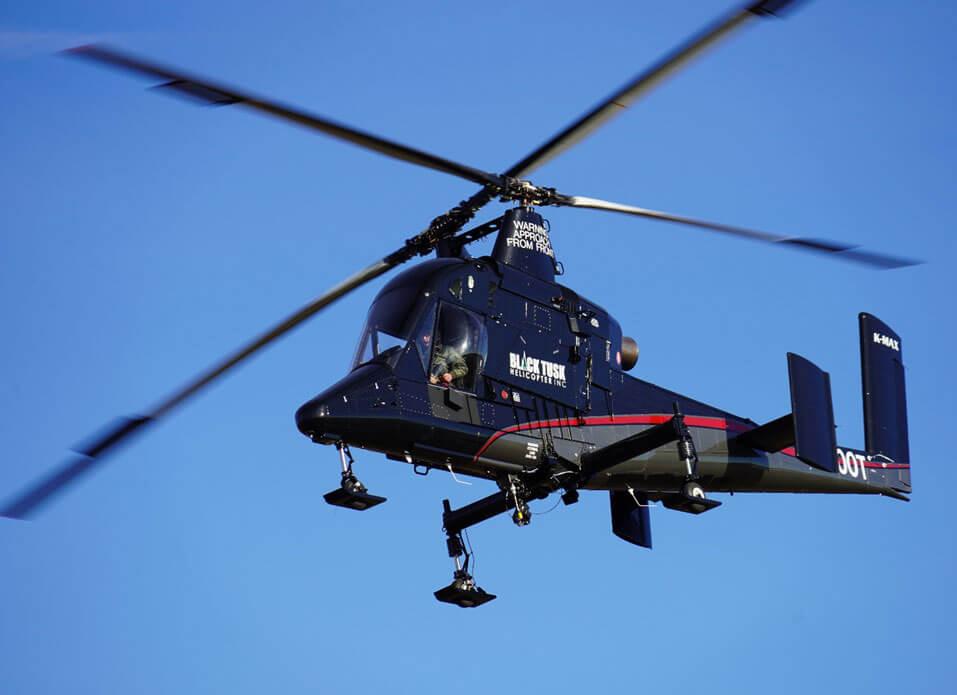
Kaman Corp. announced it delivered a new medium-to-heavy lift K - MAX helicopter to Black Tusk Helicopter Inc. of Squamish, British Columbia.
Black Tusk performs various external lift projects of every scale, ranging from aerial timber harvesting, ski tower setting, firefighting, and hydroelectric projects.
“Black Tusk is a highly respected operator, and we appreciate the confidence Black Tusk has placed in Kaman and the capabilities of the K-MAX,” said Phil Murphy, vice president of business development, Kaman Air Vehicles.
“Operators are choosing K-MAX for its proven repetitive lift capability with unmatched performance in the most demanding environments.”

“Our primary business goal is to offer our clients quality helicopter services and to ensure the longevity of our company through repeat and referral business by continuing to provide customers reliable and safe performance in all areas of our business."
"Adding a second K-MAX to our fleet is an important step towards ensuring we can continue offering our customers the most appropriate and efficient aircraft for their requirements and particular job needs,” stated Black Tusk Helicopter Inc.
The K-MAX is a rugged aircraft that features a counter-rotating rotor system and is optimized for repetitive external load operations. The aircraft can lift up to 6,000 pounds (2,722 kilograms) with excellent performance in hot and high conditions.

ITP Aero unveils DigitAl Aero AI-based digital engine management platform
Source: IPT Aero Press Release

At the MRO Americas trade show in Chicago, ITP Aero presented its exclusive DigitAl Aero software, an advanced artificial intelligence-based digital engine management platform.
DigitAl Aero is the progression of ITP Aero’s engine diagnosis and health monitoring (EDHM) tool, which was initially developed for the engines of Sikorsky S-92 helicopters in 2017 and is now in operation on 235 helicopters and aircrafts worldwide.
While EDHM can analyze 28,800 engine parameters readings in a matter of minutes, DigitAl Aero has substantially increased processing power and can complete the task in a fraction of the time, catering to the specific needs of airlines by providing complete flight data diagnostic capabilities.

DigitAl Aero employs artificial intelligence to analyze full flight data in order to calculate estimated engine removal dates. It also features a chatbot that enables users to engage in realtime conversations and access a vast amount of information and documents.
Another advantage is the high level of customization possible, offering users tools that can streamline their daily tasks and decision-making processes.
Pablo Fuentes, head of MRO at ITP Aero, said: “The launch of DigitAI Aero is a result of our ongoing discussions with various airlines. It aims to fulfil their need to leverage complete flight data instead of limited snapshot-based solutions, so that they may centralize information and transform a wealth of data into practical action plans.”
Source: Corporate Jet Investor
Author: Yves le Marquand
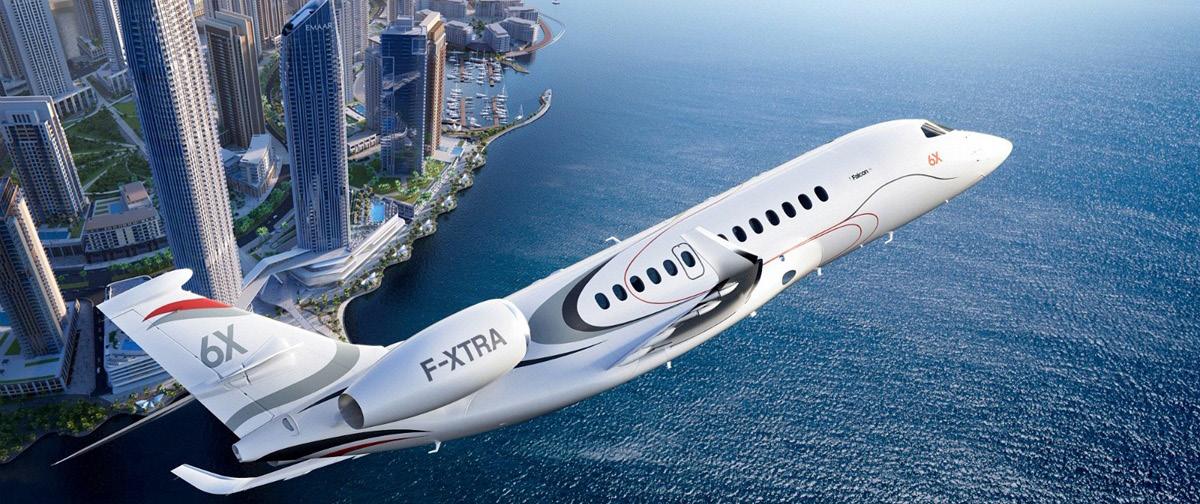
Swiss charter operator CAT Aviation has chosen Satcom Direct to equip its first Dassault Falcon 6X to enter service with a suite of connectivity solutions.
The ‘nose-to-tail’ range of solutions includes a flight-deck communication datalink and a dual cabin connectivity service that uses Iridium voice capabilities in parallel with Jet ConneX, the highspeed broadband service connected with the Viasat Global Xpress constellation. The Falcon 6X, which was re-delivered to CAT in February, is the latest aircraft to join the fleet with connectivity solutions provided by Satcom Direct.
“State-of-the-art operators flying stateof-the-art aircraft also require state-ofthe-art technology to take maximum advantage of their aircraft and provide the best possible experience for passengers and crew,” said Dave Falberg, Satcom Direct’s vice president of EMEA-APAC.
“We’re proud to be the long-time partner of CAT Aviation as the relationship supports our understanding of their requirements. Our ability to deliver customised solutions for mixed, large fleet operators supporting diverse, international missions ensures we meet the needs of clients like CAT Aviation

with our eco-system of connectivity solutions, which have been purpose-built for business aviation.”
The solution meets the needs of CAT Aviation which already uses Satcom Direct as its preferred connectivity supplier. The Zurich-headquartered operator values the closeness of Satcom’s Basel location, local language customer service and Satcom’s global footprint.
The connectivity provider’s international presence allowed it to support CAT Aviation in Little Rock, Arkansas, at the Dassault Aircraft Services facility during the aircraft interior completion.
Helene Niedhart, founder of CAT Aviation, said: “As a Dassault aircraft operator for more than 20 years, we are very proud to be the world’s first Falcon 6X operator. In 2008, we were also one of the first Falcon 7X operators. Our fleet has grown steadily, and we have become the largest Dassault Falcon operator in Switzerland. It goes without saying that our loyal and longtime CAMO, Crew and Flight Operations teams have gained huge experience in operating Dassault Falcon aircraft, and we know that we can rely on Satcom Direct for continuous support wherever we are in the world.”
Source: Moonware Press Release
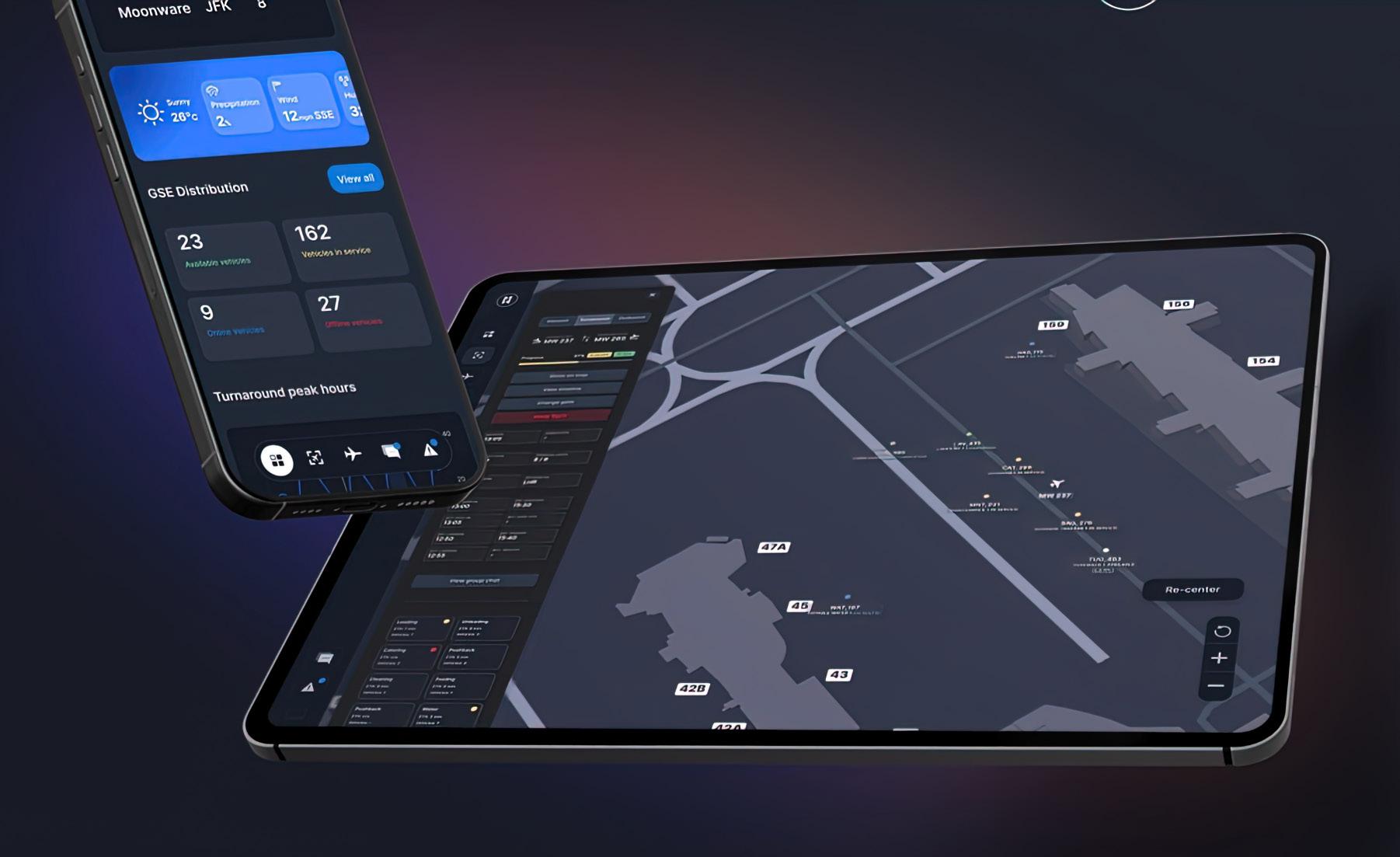
Moonware, an aviation tech startup, has successfully closed a $7 Million seed round, marking a pivotal moment in the company’s mission to revolutionize the aviation industry. This new funding, co-led by venture capital firms Third Prime and Zero Infinity Partners, with participation from The House Fund, Lorimer Ventures, and strategic private investors, positions Moonware as a dynamic and well-capitalized player ready to address operational inefficiencies in the aviation sector.
The fundraise announcement comes on the heels of successful product launches across two US airports, with British Airways and dnata at JFK and Aerocharter at LAX. In tandem with the company’s successful commercial launch and initial productmarket-fit, this round further underscores the industry’s confidence in the innovative approach Moonware has taken with HALO, the world’s first “Ground Traffic Control” platform powered by AI.
In recent years, the aviation industry has faced widespread disruptions due to delays,





cancellations, and logistical challenges, compounded by the inadequacy of existing operational systems to meet modern demands. In this landscape, Moonware’s technology offers a transformative solution, promising to revolutionize the passenger, cargo, advanced air mobility, and military sectors.
Javier Vidal, CEO of Moonware, stated: “Aviation ground operations stand at a critical juncture for necessary technological transformation, with Moonware leading the charge. This new funding round serves as great validation of our vision to modernize the sector and allows us to catalyze a new era of efficiency and innovation for the industry.”
The company’s flagship product, HALO, represents a new approach to ground handling by offering a single, comprehensive operating picture. The software consolidates various aspects of ground operations into one platform, enabling increased awareness and operational efficiency on the ramp. Unlike traditional systems that depend on
multiple legacy tools, HALO streamlines process management and decision-making for airlines. This ultimately delivers faster turnarounds, minimized delays, and higher flight throughput, reshaping the aviation landscape for enhanced efficiency and effectiveness.
“We’re excited to continue partnering with Moonware, a burgeoning leader in aviation technology”, said Third Prime General Partner Mike Kim. “This capital infusion sets up the stage for transformative growth, reshaping aviation standards and driving transformation across industries embracing digital evolution.”
“We’re humbled by the support from our incredible team, investors, and customers in getting to this point. We anticipate high growth in the coming years, and this fundraise will serve Moonware to scale globally across a wide range of deployments”, commented Saunon Malekshahi, Moonware’s CTO.
With this funding, Moonware will bolster its R&D efforts and expand its team of top-tier talent drawn from leading Silicon Valley tech firms and aviation industry giants. The fresh capital will not only position Moonware as a leader in the sector but will also reinforce its collaborative ties with airlines and airports, propelling us towards a future defined by automated and intelligent airfield solutions.
For more information about Moonware and its products, visit moonware.com or reach out to contact@moonware.com.
Moonware is a venture-backed startup enabling the next generation of aerial mobility with automated and sustainable airfields. The company is building an integrated ecosystem of AI software and smart vehicles that optimally connect ground crew, aircraft and ground support equipment to efficiently service flights. Moonware’s vision is to handle aircraft fully autonomously from touchdown to takeoff, providing seamless aircraft turnarounds for a streamlined airport experience.

Source: AirSuite Press Release
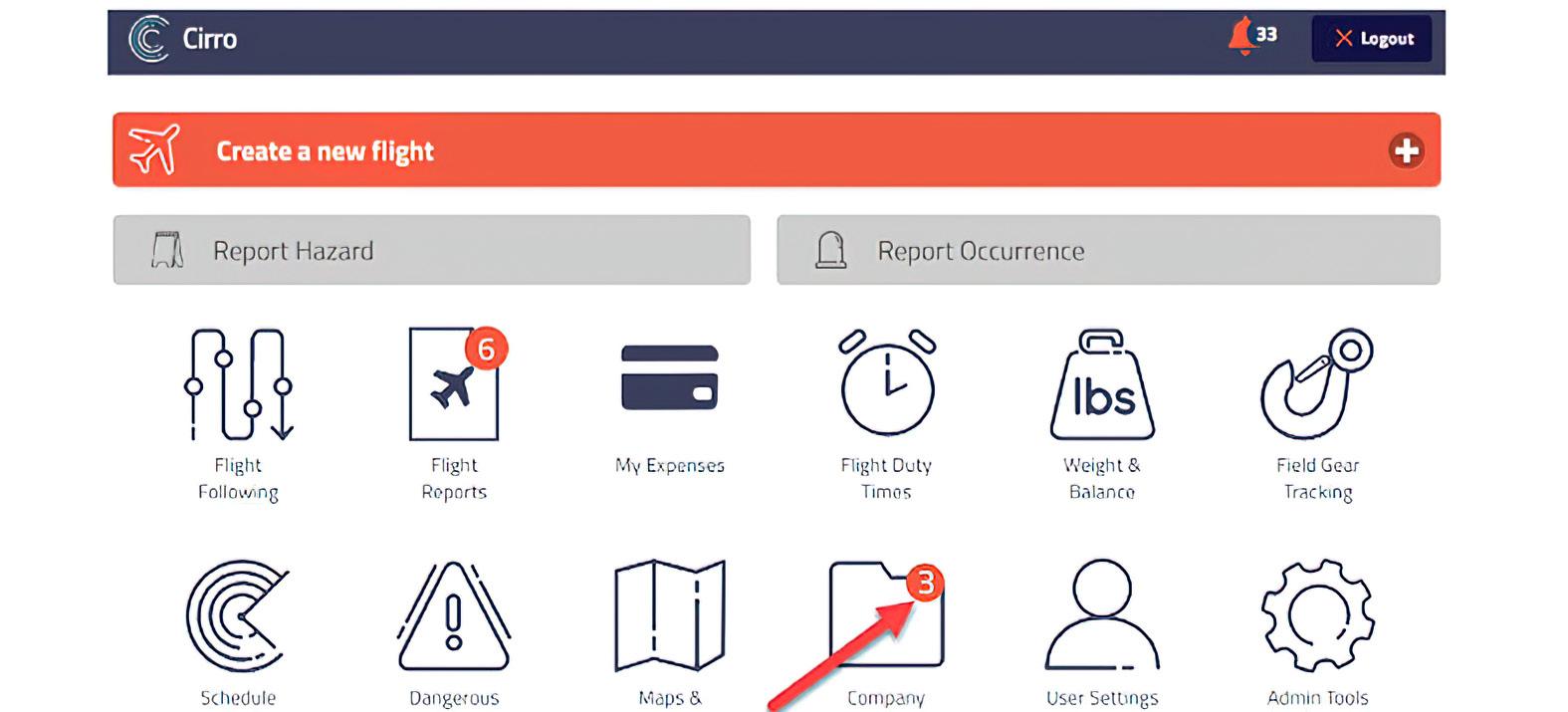
Cirro by AirSuite, an innovator in aviation operations software, announced that its flight operations management system has been selected for use by the Aircraft Services Directorate, the Air Operator within Transport Canada.
This contract stems from a thorough request for proposal (RFP) process for a provider of flight management software to optimize flight operations in support of Environmental Monitoring and Surveillance, Canadian Coast Guard operations, and government airlift.
The contract sparks the creation of several new jobs at AirSuite that will be headquartered in Thunder Bay, contributing to growth in the tech sector in Northwestern Ontario.
Cirro by AirSuite is committed to regulatory compliance, with demonstrated excellence in custom development, and strong customer support to meet the unique needs of the Canadian aviation industry.
“We are honored to be the flight operations software provider on this multi-year federal contract. This contract underscores Cirro’s commitment to pushing the boundaries of innovation. We’ve been at the forefront of the Canadian aviation tech industry for nine years, and we continue to deliver reliable, secure, and efficient solutions,” said Michael Kleywegt, CEO of

AirSuite and founding senior developer.
“Congratulations to the entire team at AirSuite on securing this contract! Your focus on collaboration and partnerships have played a key role in driving our local economy and ensuring that Northwestern Ontario remains competitive. It is exciting to see your leadership and growth as you continue to make significant contributions to the aviation tech industry,” said Patty Hajdu, Member of Parliament Thunder Bay-Superior North and Minister of Indigenous Services and FedNor.
“Securing this high-level contract is testament to our team’s dedication to compliance and safety, and to our vision to provide unique, user-friendly solutions for our colleagues in the industry,” said Doug Carlson, chief operating officer of AirSuite and an associate director to the Helicopter Association of Canada board of directors.
Cirro’s comprehensive suite of tools digitizes all aspects of operational duties from pre-flight planning to post-flight reporting, providing the user with advanced oversight on complex operational responsibilities including tracking and reporting on flight duty times, aircraft weight and balance calculations, transportation of dangerous goods, safety management, fleet scheduling, and all details of aircraft, crew and resource management—all with the focus on federal and international regulatory compliance.
Source: Corporate Jet Investor
Author: Mike Stones

Bombardier is claiming to be the first business jet manufacturer to reveal the environmental impact of its portfolio, after providing public access to the footprint of all in-production aircraft.
The manufacturer’s Environmental Product Declarations (EPDs) are a key part of its strategy to contribute to more sustainable aerospace industry, delivered a year ahead of schedule, it said. “Challenger 650 aircraft joins Bombardier’s Challenger 3500, Global 5500, Global 6500 and Global 7500 aircraft as the only business jets in the world to carry an EPD,” according to Bombardier. The declarations enable the company and its partners to mitigate the environmental footprint of their products, it said.
But the initiative is not designed to deliver direct commercial advantage. “The role of EPDs is not to stamp our aircraft as more sustainable than others, rather to take ownership of the environmental impact they generate,” said Jean-Christophe Gallagher, executive vice president, Aircraft Sales & Bombardier Defense, Bombardier.

Environmental reports can be consulted like any other specification document, he added. “The same way we provide factual information about the unmatched width of the Challenger 650 aircraft’s cabin in its category or its leading dispatch reliability, Bombardier [now] publicly provides factual information on the environmental impact of its business jets.”
The EPDs can also be used as a reference guide to target improvement areas in the short- or medium-terms, he added. Environmental details on display include: aircraft CO2 emissions generated at each step of the value chain from raw material extraction until aircraft end-of-life.
Bombardier started this scientific analysis during the development of its Global 7500. The aircraft became the first business jet to receive a third-party verified EPD in 2020. Bombardier published a self-declared EPD for its Challenger 3500 aircraft in 2022, for its Global 5500 and Global 6500 aircraft in 2023, and now its Challenger 650 jet.
Meanwhile, read full details of all Bombardier’s business jets EPDs on the company’s website.
Source: eVTOL Insights
Author: Chris Stonor
Bristol-based UK startup, Sora Aviation, is developing an eVTOL bus with zero emissions, low noise and affordable ticket prices for the Advanced Air Mobility (AAM) market, writes wearefinn.com, who recently interviewed company co-Founder and CEO, Furqan.
Furqan served as the Technical Authority on AAM at GKN and has led multiple electric, hybrid and hydrogen aircraft development programs from conceptual design to flight testing. A Fellow of the IMechE, he chairs the ADS Advanced Air Mobility group in the UK.
He works alongside company CTO, Malcolm Foster, who has over 40 years of experience in aircraft design at Piper, Bell, AgustaWestland, GKN and the ATI as well as on the Eviation Alice. Foster holds a lifetime achievement award from the Vertical Flight Society.
The name Sora ( 空 ) is Japanese for Sky.
Where did the concept for an eVTOL bus come from?
Five years ago we had the idea for an eVTOL bus when we were at GKN. Several OEMs were designing eVTOLs, Uber elevate had just popularised the idea of air taxis, and we were looking into that market for GKN. We realised most of the market data showed significant opportunity in airport shuttles going from downtown to the airport, and airport to downtown in a city.
We looked at that market and we thought, if you’re going to go from downtown to the airport, why would you do it four people at a time, those routes are really dense in terms of demand.


Do you foresee strong demand?
They’re really good use cases. Nobody wants to drive to the airport, where parking is often limited as well as prohibitively expensive and willingness to pay is higher due to time sensitivity. So they’re really good AAM routes. Yet, from a passenger scalability point of view, four passengers didn’t really make sense to us for those routes. Around the same time, there were a lot of questions about the costs of urban air mobility, so we started looking at ways to get expenditure down and one of the best ways is to carry more people, because you split the cost of the trip over a greater number of passengers.
There are several eVTOL concepts out there, but they’re generally one to six passenger aircraft. The S - 1 is the only credible eVTOL bus approach out there that’s being commercially pursued, and that’s one thing that led us to take a step forward with the support of our investors. We think entry into service for an aircraft like this will be around 2031.
How are you managing the infrastructure challenges that come with a larger eVTOL?
A typical 5 seat air taxi today might have a maximum dimension of 15 to 16 metres,
that’s consistent with a small to medium helicopter. The 30-seater we’re developing has a maximum dimension of about 22 metres, so it is bigger, but it’s not ridiculously bigger for the number of passengers it carries. One of our goals now is to engage with infrastructure developers and make them aware that these kinds of vehicles are on the way with very favourable economics and therefore their requirements should be considered during vertiport design.
Why haven’t other eVTOL developers launched a ‘bus’ before now?
Uber were really the driving force behind making people realise that a potential market existed around advanced air mobility. Their entire operational focus was around four to five seat ground vehicles and that translated to their eVTOL studies. Most early developers were working with Uber, and Uber made it clear they were interested in five seaters.The company has since sold the Elevate business.
The second bit is a misconception that a larger electric aircraft needs magically better batteries. It requires better batteries if you want to go a significantly longer range, but if you’re only trying to go the same range as a small electric aircraft, and do the same missions, you can do that on existing ones. If you can go 100 miles in a five seat eVTOL, you can go 100
miles in a 30-seat eVTOL, you just carry a proportional amount of batteries.
We do believe that a number of small eVTOL companies will eventually want to transition to a larger aircraft, but doing it at a small scale and getting to market first for them is a priority, and if you want to do that then a smaller aircraft is just quicker and cheaper.
How does the certification pathway look?
EASA’s certification requirements for eVTOLs are already consistent with commercial transport aircraft safety targets. From a precedent point of view, larger certified rotorcraft than the S - 1 fly around the world today.
One advantage we will have is that a number of the air taxi companies will have certified years before us, and that’ll really help inform a lot of our development and certification work. We won’t have to push the pioneering of all of these regulations. They will be in place and be well established by the time we’re targeting certification.
For more information
https://www.soraaviation.com/about (News Source: https://www.wearefinn.com/)

Source: Revolution.Aero
Author: Yves le Marquand
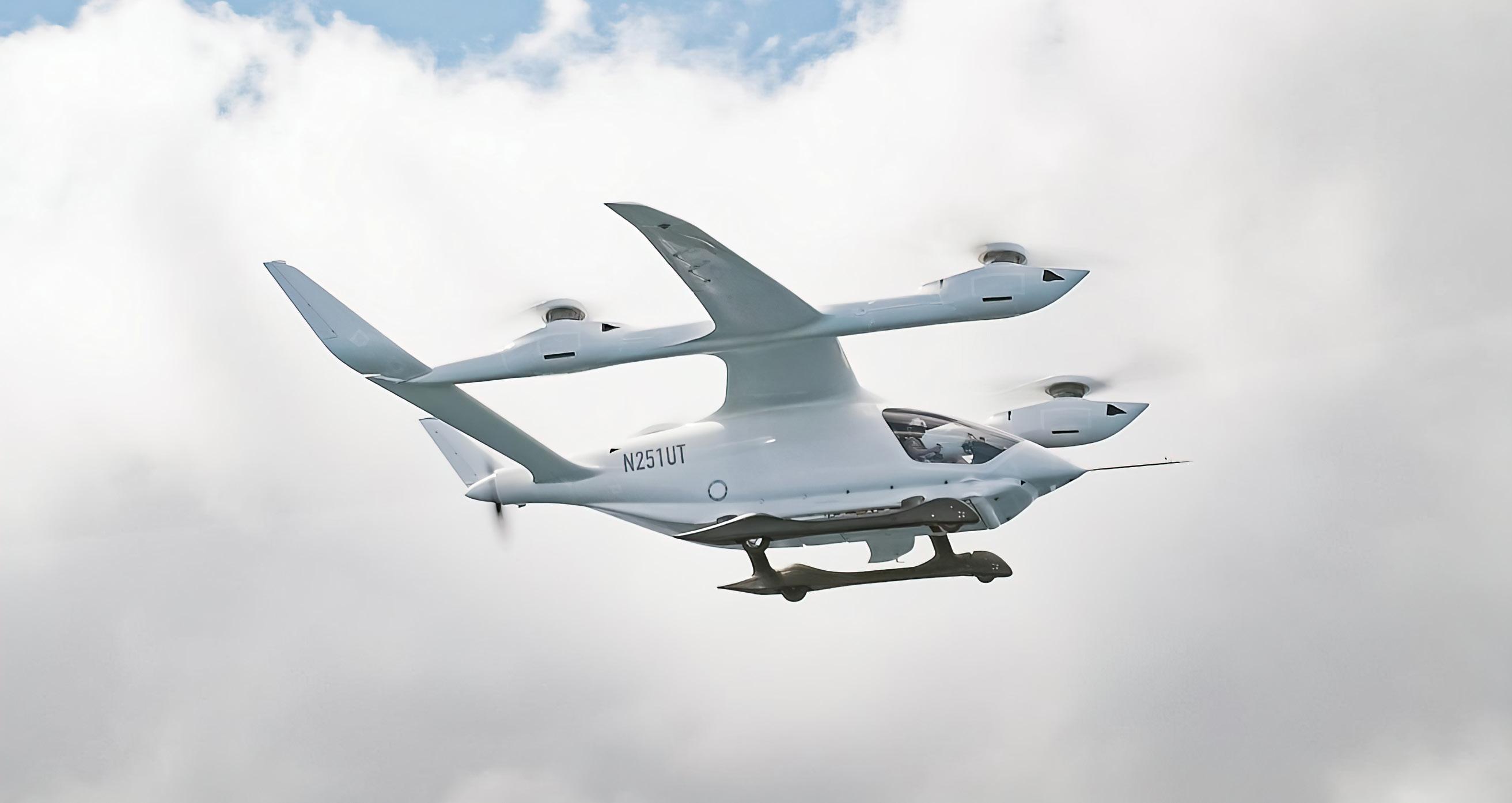
BETATechnologies has successfully a flown piloted transition test in the VTOL version of its Alia aircraft.
The tests were completed earlier this month at BETA’s base in Plattsburgh, New York. Having earlier successfully completed single phases, the test flight marked the first time BETA had a flown a full transition with a pilot on board.
At the controls was Nate Moyer, BETA test pilot and former US Air Force experimental test pilot. “The transition is massive technological hurdle for aviation, being able to safely cross that is huge. It is big for the business, but it is also big for the industry as a whole,” he said.
The data collected from this test and all the tests leading up to the full transition will feed into further testing as BETA expands the flight envelope of its VTOL aircraft (aka A250). This will include assessment of the handling characteristics, testing the aircraft to the limits of its capability and continued safety verification of operational scenarios.
The transition, where a VTOL aircraft moves from vertical to horizontal flight and back again for landing, is a critical part of the flight pattern and a key milestone for any VTOL developer to hit. It represents one fairly large step of many towards certification. It is described

by BETA’s founder and CEO Kyle Clark as the point at which a VTOL moves from flying like a helicopter to flying like an airplane.
“We’ve been testing over the last several years all of the different data points to bring it [Alia] through transition,” said Clark. “Everything is aligned; the propulsion, the energy storage, the physics, the structure. We’ve got a hell of a team there to make sure every thing that is in our control, we control it and do it really well.
“It is no harder than any other step, but it is the step that everybody knows.”
BETA has now flown ALIA prototypes for more than four years, clocking more than 40,000 nautical miles in total across both VTOL and CTOL version of its aircraft. Its runway independent VTOL will first be used by the military, then cargo carriers, followed by passenger carrying operators.
Meanwhile, last week BETA’s Charge Cube was certified by the Underwriter’s Laboratory (UL), the OEM is the only electric aircraft developer with UL-certified infrastructure. This latest charger will join BETA’s growing network across the US and Canada. To date, the firm has certified chargers online at more than 20 airports across America, with more than 50 airports, heliports and vertiports in development.
Source: eVTOL Insights
Author: Chris Stonor
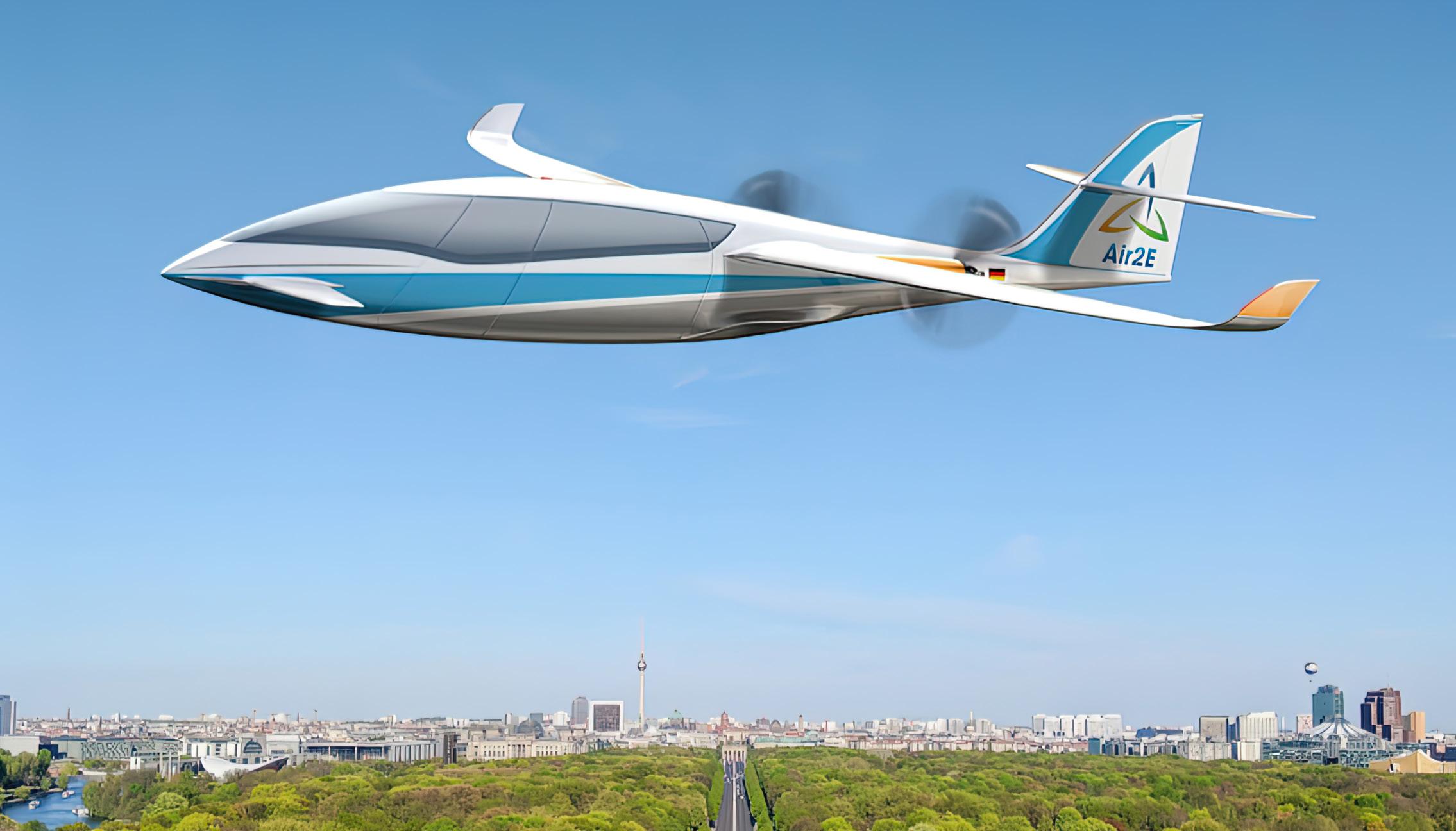
aerospace has agreed orders for its aircraft from Air2E and Hopscotch Air.
The deals bring ELECTRON’s sales pipeline close to EUR 200m, and with Air2E based in Germany and Hopscotch a US company it shows the global interest for the aircraft.
The aircraft, aka Electron 5, will feature a 750km (466 miles) range with today’s batteries. This capability exceeds most mission profiles in both the USA and EU, where similar aircraft today cover routes below 500km (311 miles), according to the ELECTRON team. The firm is poised for launch in 2028.
Marc-Henry de Jong, CCO and co-founder at ELECTRON aerospace, told us: “It shows that we listened well when establishing top-level requirements for our aircraft. Existing operators, like Air2E and Hopscotch Air, now placing orders, validates all our hard work to date.
“Securing orders from two pioneers in the regional air mobility sector like Air2E and Hopscotch Air affirms the market fit of our Electron 5 aircraft. It’s a testament to the trust and commitment





our partners place in our vision for a sustainable aviation future.”
According to its creators, Electron 5 offers operators over 50% reduction in operating costs compared to existing internal combustion engine (ICE) aircraft.
“Our Electron 5 will replace ICE aircraft like Cirrus aircraft and/or DA62 aircraft,” added de Jong. “The goal of our customers is to become zero direct CO2 emission operators as soon as possible.”
Norbert Werle, CEO of Air2E, added: “The Electron 5 will empower Air2E to deliver our services with zero direct CO2 emissions, in line with our dedication to fully sustainable business travel.”
The parties have each signed a Memorandum of Understanding (MoU) featuring explicit payment schedules.
Andrew Schmertz, CEO at Hopscotch Air, said: “The reduced operating costs of the Electron 5 will allow us to significantly broaden our customer base, providing more affordable and accessible air travel alternatives.”
propel future of Australian
Source: eVTOL Insights
Author: Chris Stonor
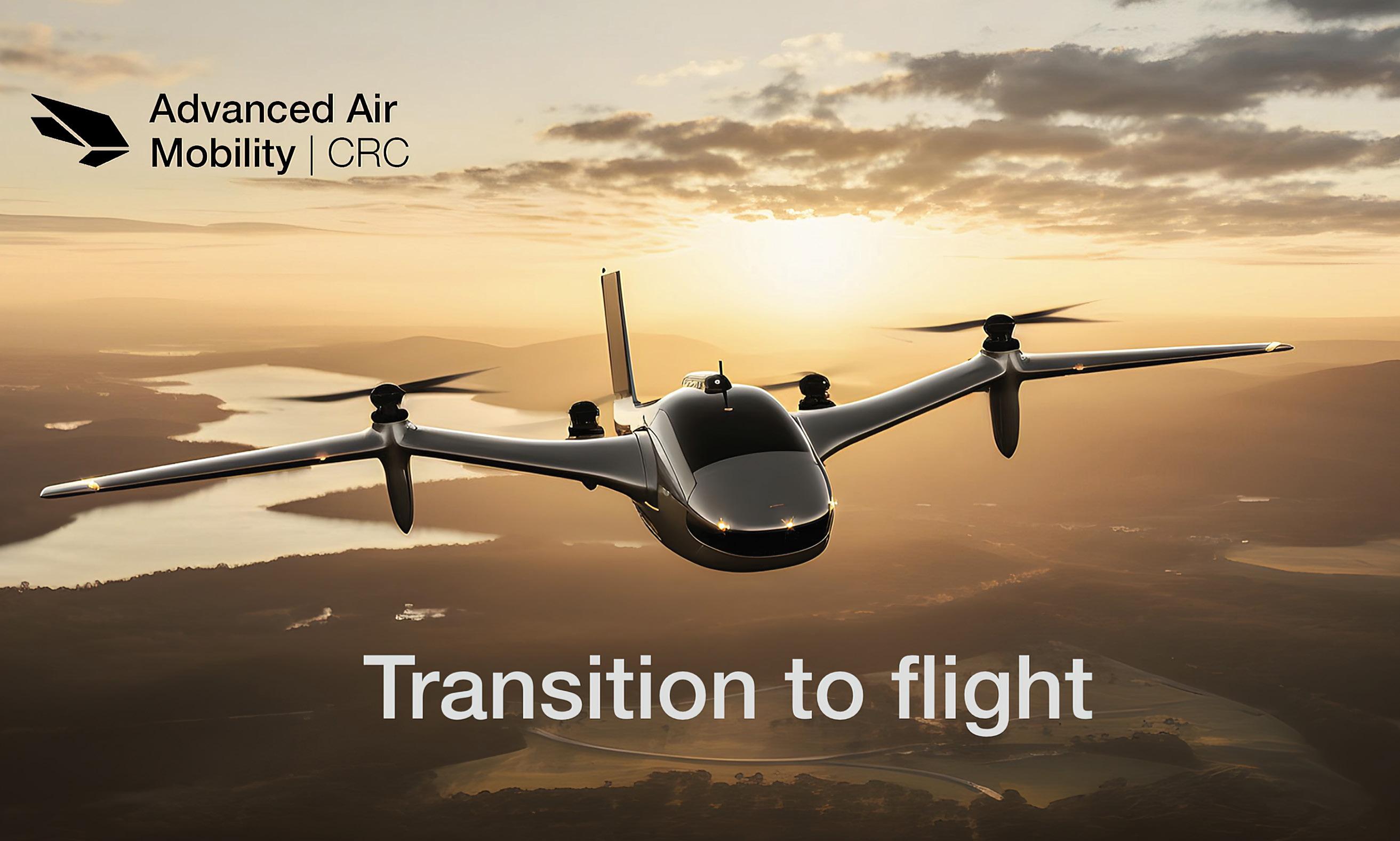
The Advanced Air Mobility (AAM) Institute is collaborating with the AAM Cooperative Research Centre (CRC), to propel the aviation landscape in Australia, reports a press release.
With a shared mission to lead research, development, education and training in emerging aviation technologies, the AAM CRC aims “to drive innovation, safety, and sustainability across air vehicles, operating systems, and ground infrastructure,” explains the release.
The CRC application demonstrates “a robust collaboration, attracting industry interest and potentially positioning as Australia’s largest cooperative research center for aviation and aerospace,” continues the release.
The body has set forth key objectives: -
• First and foremost, the fostering of partnerships among diverse stakeholders to expedite the advancement of AAM.

• The procurement of the safest, most costefficient air vehicles for both transportation and emergency services.
• A strong commitment to sustainable solutions, including efforts to mitigate environmental impact while preserving operational efficiency.
• The strategic integration of AAM industry leaders and researchers for the 10-year vision. Notably, the successful submission of the Stage 1 application for the Round 25 CRC grant program last month. Results are expected in June with preparations underway for the Stage 2 application.
Dr. Adriano Di Pietro, Interim CEO at AAM CRC commented, “Considering Australia’s unique landscape, diverse requirements, increased urbanisation, and the need for carbon emission reductions, innovation in aviation will have game-changing impacts on our country’s supply chain.”
Meanwhile, the AAM Institute has announced the appointment of Giancarlo Silvestri as the Regulatory Affairs Officer (RAO) serving for the Board of Liaisons. He will serve as the Central RAO covering Europe, the Middle East and Africa. The Institute will appoint Officers in the near future for the East and West regions.
In his new role, Silvestri is responsible for providing strategic guidance and expertise on regulatory matters to the Institute’s Board of Liaisons. With a diverse background including commercial aviation and government affairs, he remarked, “With over 20 years of experience in the aviation industry, I am passionate about safety, regulatory development, and innovation. Having witnessed the progression of AAM since its inception, I am proud of the industry’s recent progress.”
He continued, “We’ve established a new regulatory framework with support from key agencies such as EASA, FAA, and UK CAA… as well as explored challenges like the safe management of lithium-ion battery thermal runaway and associated risks. In this leadership position, I aim to advocate for electric aviation, airspace modernisation and a more inclusive ground infrastructure experience.”
The Institute’s Founder and President, Dan Sloat, added, “Our Liaisons will benefit greatly from Giancarlo’s insights, especially in the Central Region of Europe, Middle East, and Africa.”
The release goes on, “The AAM Institute Board of Liaisons plays a crucial role in advancing the development and implementation of AAM for their respective regions. The addition of a dedicated RAO will further strengthen the organization’s ability to address regulatory challenges and promote the safe and efficient integration of Advanced Air Mobility in collaboration with the representatives’ local communities.”
For more information
https://aaminstitute.org/
https://www.aamcrc.com.au/

Source: Revolution.Aero
Author: Yves le Marquand
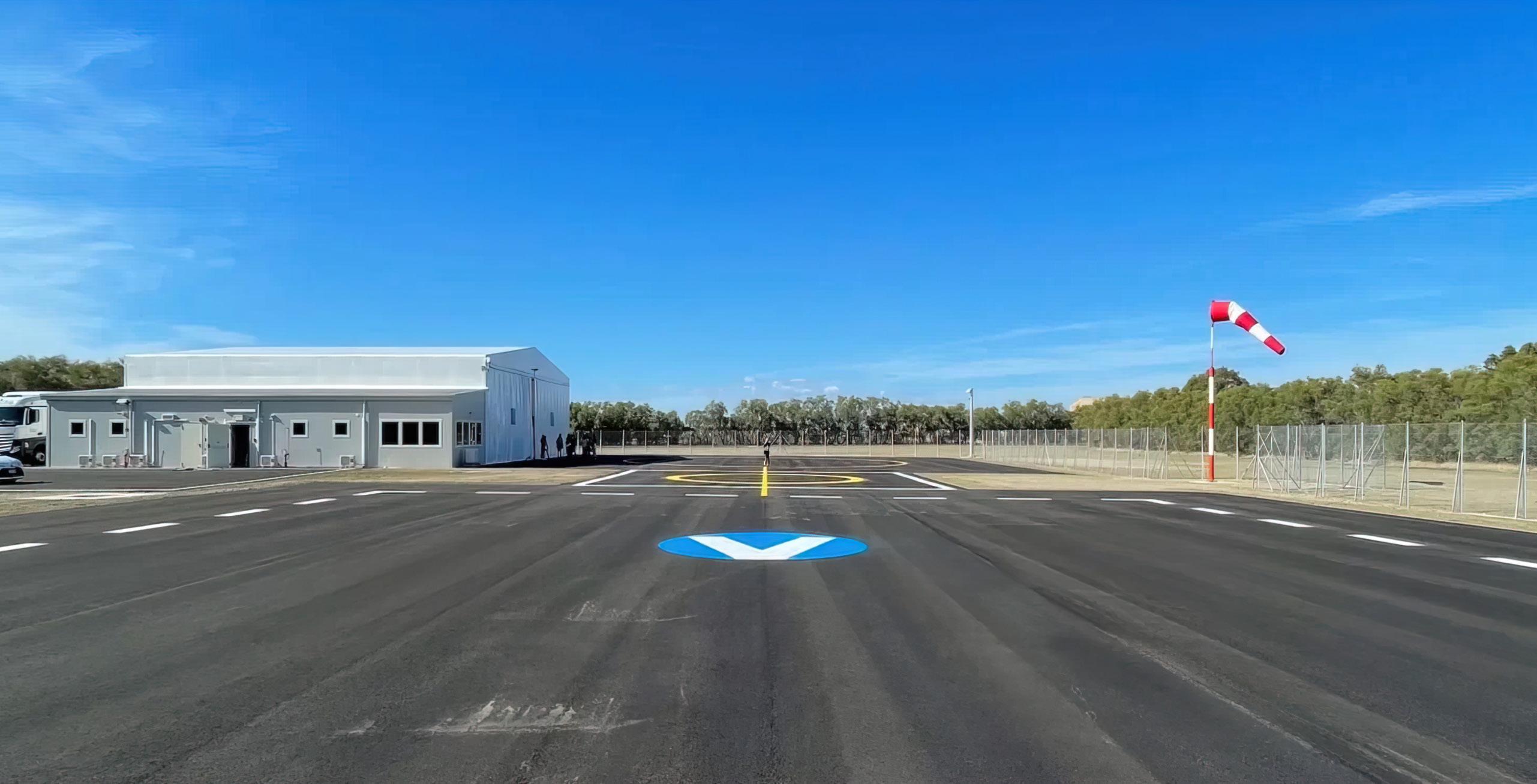
UrbanV’s test vertiport on the outskirts of Rome is testing an AI-powered bird concentration monitoring system designed by The Edge Company.
The system, which is designed to to combat bird strikes at airports, was installed at the Test Vertiport UV-0 in Fiumicino, Rome last December. It captures images to map the local wildlife and address potential obstacles that may arise during air taxis’ flight phases, enabling UrbanV to monitor any risks associated with bird strikes and uncooperative obstacles in real time. Video data captured by cameras is then processed by AI into aggregated, verifiable data.
“The Edge Company has developed an automated bird monitoring system based on its extensive experience in the aerospace sector, combining cutting-edge technologies such as AI with natural sciences, revolutionising the approach to mitigating bird strikes,” said Fabio Masci, CEO of the Italian firm. “Following a period of acceleration in France in 2018, where Airbus engaged us in anticipation of the forthcoming launch of new urban mobility initiatives, we adapted our BCMS system to

cater to this emerging market, turning it into a non-cooperative obstacle detection.
“With our system, which has no electromagnetic emissions and can be safely installed even in residential areas, we ensure constant situational awareness. This added layer of safety benefits everyone: passengers and citizens alike.”
UrbanV’s vertiport, aka UV-0, is located within a designated “regulatory sandbox”, an experimental zone carefully selected and approved by the Italian Civil Aviation Authority. This set-up allows the testing of complex interfaces between controlled airspace, similar to that of an international civil airport and the operational airspace essential for AAM.
Carlo Tursi, CEO of UrbanV said: “At UrbanV, our mission is to improve people’s lives by providing a fast, efficient, safe and environmentally friendly alternative for transporting people and goods over short distances by air. Our vision is to become a prominent global operator of vertiport networks, starting with Italy and France, where we are working with our founding partners to establish the first AAM routes on a global scale.

DroneUp and Blueflite partner “to bring advanced commercial drone capabilities for fast, safe and reliable deliveries”
Source: Revolution.Aero
Author: Yves le Marquand
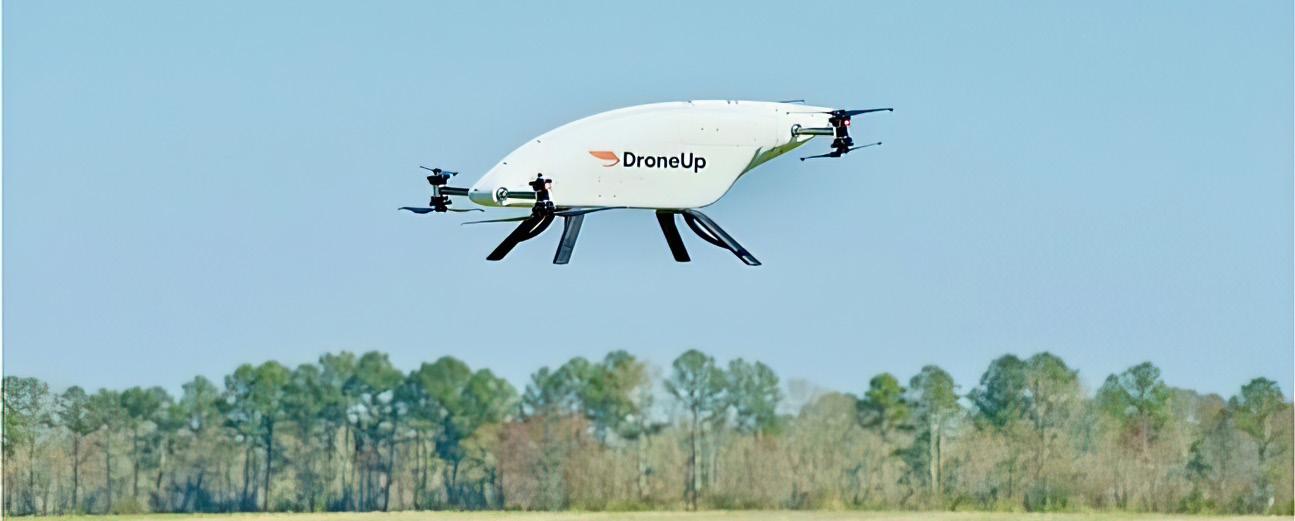
DroneUp, a leading U.S drone delivery company, announced this week a partnership with Blueflite, a cutting-edge drone technology firm, reports a press release. The collaboration aims to bring advanced fast, safe and reliable last-mile drone deliveries.
The announcement comes after months of joint collaboration and on the heels of DroneUp’s recent unveiling of its innovative Drone Autonomous Ecosystem, “a platform that promises to revolutionise the delivery industry,” explains the release.
Meanwhile, with its advanced drone capabilities, including internal package storage and high-speed flight, Blueflite’s technology “is a perfect fit for DroneUp’s Ecosystem, ensuring quick, safe, and reliable deliveries within a 15-mile radius of partnered vendors,” continues the release.
John Vernon, CTO of DroneUp, remarked, “Our selection of Blueflite as a partner was based on their innovation capabilities and

technological excellence. Their vision aligns with ours and we’re excited about the future of the collaboration, as it strengthens the backbone of our Autonomous Ecosystem.”
Frank Noppel, CEO of Blueflite, added, “By pooling our resources and expertise, we’re not just advancing drone delivery technology, we’re making it more accessible and efficient for everyone, setting new industry standards along the way.”
The release continues, “While DroneUp plans a phased rollout of the Ecosystem in select markets in 2024, Blueflite is geared up to support this pioneering venture, aiming to deliver transformative solutions that will benefit businesses and consumers worldwide.”
This collaboration comes at a time when drone delivery is on the rise across America and retailers, QSRs and c - stores look for new, innovative ways to put goods in their consumers’ hands at a fraction of the traditional delivery cost.
Rise DFR Village launches as training ground for drone first responders
Source: Skyfire Consulting Press Release
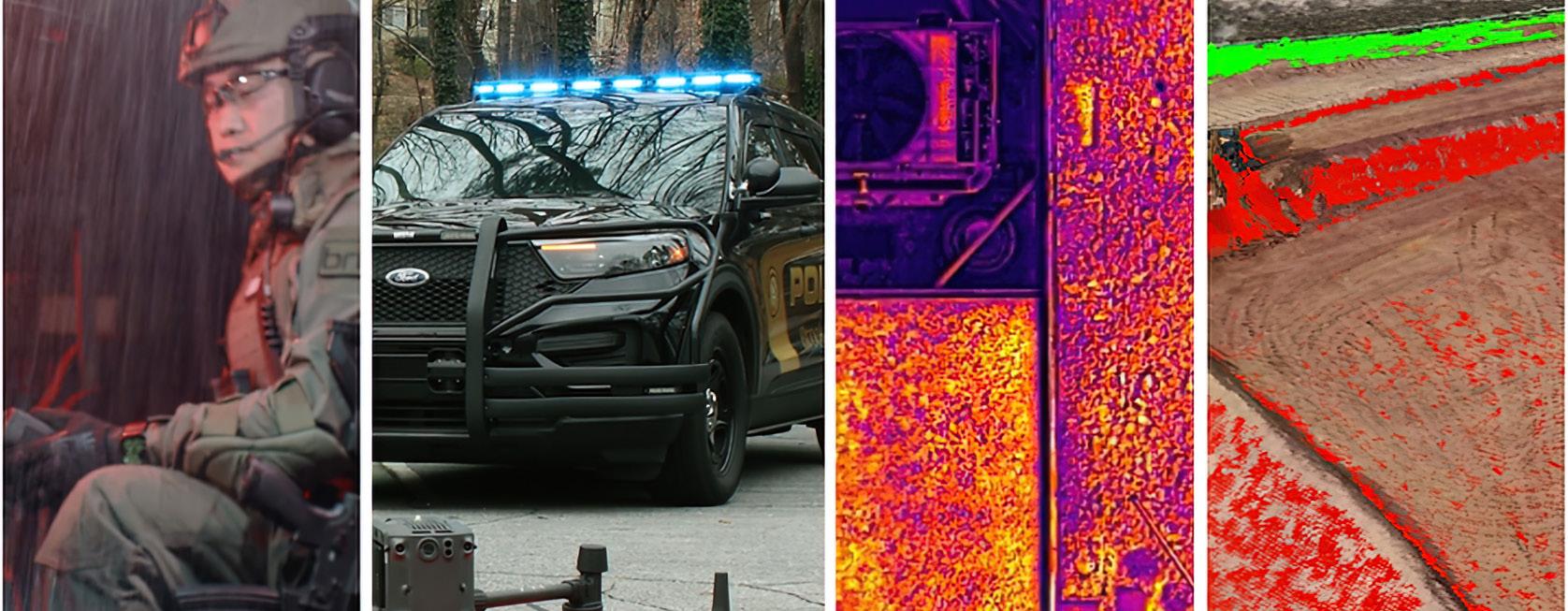
Skyfire Consulting (Skyfire) the public safety UAS consulting group, announced the launch of Rise DFR Village, a training ground for drone first responders (DFRs).
This one-of-a-kind facility provides public safety agencies, military/DOD, critical infrastructure, and private industry with best-in-class testing, training, and demonstration grounds to advance and adopt DFR programs.
“Rise DFR Village represents a significant leap forward in the integration of drones into public safety operations, and Skyfire is grateful for the support of the Huntsville International Airport and the City of Huntsville,” said Matt Sloane, Skyfire founder and CEO.
“By providing a realistic training environment and collaborating with industry leaders, we are empowering first responders to leverage this lifesaving technology to its fullest potential.”
Rise DFR Village offers a comprehensive training experience designed to prepare first responders for real-world DFR operations. Key features of the facility include:
• Realistic training scenarios: Rise DFR Village replicates a variety of environments that first responders may encounter, including urban settings, disaster zones, and rural areas.
• Collaboration with industry leaders: The Village collaborates with leading drone manufacturers and software developers to provide attendees with access to the latest

technologies.
• Focus on integration: The training curriculum emphasizes integrating DFR operations into existing public safety workflows.
Rise DFR Village is poised to revolutionize the way public safety agencies utilize drones. By providing a world-class training ground and fostering collaboration, the Village is paving the way for the widespread adoption of DFR programs across the country.
Founding partners include, BRINC, Parrot, AirData, DroneSense, Motorola (CAPE), Echodyne, DeDrone, Huntsville Police Department, and University of Alabama Huntsville.
A portion of Rise DFR Village will be prominently displayed during the second annual Future Proof DFR & Airspace Awareness Summit May 8-10. Tickets are free for public safety and military/ DOD. Learn more about this experiential summit.
Drone First Responders (DFRs) are unmanned aerial systems (UAS), commonly known as drones, utilized by public safety personnel trained to enhance emergency response capabilities. Drones offer a variety of advantages in public safety situations, including:
• Improved situational awareness
• Improved response times
• Enhanced search and rescue operations
• Firefighting support
• Hazmat material identification
• Law enforcement support
Source: eVTOL Insights
Author: Chris Stonor
Innovate
UK, in partnership with the Department of Health and Social Care (DHSC), has announced the latest group of drone projects to receive funding from the UKRI (UK Research and Innovation) Future Flight Challenge, reports a press release.
The program supports the innovative use of drones to help build robustness in UK medical supply chains and help connect patients with healthcare services more rapidly.
Five UK-based projects will share UKP500,000 to create “a deeper understanding of how drones could strengthen and future-proof healthcare logistics,” explains the release.
The funded projects are:
Versatile Package Provenance System (VPS) — A project enabling real-time monitoring of crucial healthcare packages between NHS Trusts, couriers, drones and vans.
Pioneering Radiopharmaceutical Drone Delivery
— A project helping to deliver bigger, critical goods packages over longer distances more safely. Delivered in partnership with the University Hospitals Coventry and Warwickshire NHS Trust and Siemens Healthcare.
Welsh NHS Medical Drone Delivery Network
— A project focused on delivering savings using autonomous drones embedded into the wider health network. The project will be delivered by Snowdonia Aerospace, SLiNK-TECH, and the Welsh Health Drone Innovation Partnership, led by Welsh Ambulance Services NHS Trust for NHS Wales with the Welsh Blood Service.
Dr-UBER: Drone Network for Medical Emergency Delivery in Essex — A project expanding the ridehailing concept to connect medical institutions such as hospitals, pharmacies, GPs, and medical laboratories. This project has been developed by Airborne Robotics in partnership with Anglia Ruskin University.
DROnes in Pathology NETworks (DroPNet) — A project looking at how to simplify the use of drones to support the movement of pathology testing between NHS facilities. This project is working alongside the Kent and Medway Pathology Network.
These projects form part of UKRI’s UKP300 million Future Flight Challenge. “The program is co-funded






by government and industry and is supporting the creation of the aviation ecosystem needed to accelerate the introduction of advanced air mobility (AAM), drones, and electric sub-regional aircraft in the UK,” says the release. “The challenge is delivered by Innovate UK and the Economic and Social Research Council (ESRC).
Andrew Stephenson, a UK Health Minister, commented, “Technology has huge potential to transform the NHS for patients, but it can also help automate processes behind the scenes too. These projects will help futureproof our medical supply chains by using drones to deliver medical products, reducing the chances of supply disruption while saving costs, energy and resources.”
He continued, “If successful, they could be rolled out across the NHS to boost resilience and help people live more independent lives, building on the government’s long-term ambitions.”
Simon Masters, Future Flight Challenge Deputy Director, added, “We are committed to leading a revolution in aviation, delivering technology solutions with economic and societal benefits. This partnership between the drone industry and the medical sector highlights the value that drones can bring to our frontline public services.”
Domestic and international medical goods supply chains are dependent on each other, meaning the supply of medical goods in the UK can be disrupted by events around the world. To make domestic supply more reliable, UKRI is promoting crosssector innovation to strengthen and build long-term resilience.
Source: ANRA Technologies Press Release
ANRA Technologies, a provider of uncrewed traffic management and operational solutions, announced a significant enhancement to its U-space services.
By integrating advanced simulation and modeling capabilities, ANRA further empowers stakeholders to optimize airspace usage, mitigate risks, and enhance operational efficiency for urban air mobility (UAM) operations.
Key features of ANRA’s advanced simulation and modeling services include.
Realistic Simulation: ANRA’s state-of-the-art simulation tools provide stakeholders with highly accurate virtual environments to replicate real-world scenarios, enabling comprehensive testing and validation of UAM operations.
Real-time simulation capabilities allow stakeholders, including city planners, air navigation service providers (ANSPs), civil aviation authorities (CAAs), and UAM operators, to assess and adapt to dynamic airspace conditions in real-time, ensuring safe and efficient operations.
Dynamic Modeling: Leveraging advanced algorithms and data analytics, ANRA’s platform dynamically models airspace dynamics, traffic flows, and environmental factors to predict and optimize operational performance.
Fast-time simulation capabilities enable stakeholders to evaluate various scenarios and assess the impact of proposed changes to airspace management procedures, infrastructure deployment, and regulatory frameworks, facilitating informed decisionmaking and strategic planning.
Integration with Ground-Based Digital Infrastructure: ANRA’s simulation and modeling capabilities seamlessly integrate with groundbased digital infrastructure, such as ANRA’s vertiport management systems (VMS), to provide a holistic view of UAM operations.
By incorporating data from VMS and other ground-based systems, stakeholders can optimize vertiport operations, streamline ground handling procedures, and enhance overall operational efficiency.


Risk Assessment and Mitigation: ANRA’s simulation capabilities allow for detailed risk assessment and mitigation strategies. By injecting real-time data, stakeholders can identify potential hazards and implement proactive measures to ensure safety. By simulating potential scenarios and analyzing the associated risks, stakeholders can develop robust contingency plans and operational procedures to mitigate risks and enhance overall safety.
Scalability and Flexibility: Designed to scale with the evolving needs of the UAM industry, ANRA’s simulation and modeling capabilities are adaptable to a wide range of use cases, from urban air taxis to drone delivery services. The platform’s flexibility enables stakeholders to customize simulations according to specific operational requirements, aircraft types, regulatory frameworks, and infrastructure configurations, ensuring alignment with industry standards and best practices.
“We are excited to unveil our enhanced U-space services with advanced simulation and modeling capabilities,” stated Amit Ganjoo, founder and CEO of ANRA Technologies. “By combining cuttingedge technology with our extensive expertise in UTM solutions, we are empowering stakeholders to unlock the full potential of urban air mobility while prioritizing safety and efficiency.”
Source: eVTOL Insights
Author: Chris Stonor
Wingcopter, a leading drone delivery company, announced this week it has embarked on the Type Certification (TC) procedure for Japan with support from the ITOCHU Corporation, reports a press release.
The German-based Wingcopter has applied and received acceptance for beginning the TC process of its Wingcopter 198 delivery drone. “This marks the first time a foreign company’s drone and the first time a fixed-wing drone has been accepted under the unmanned aircraft class-1 type certification by the Japan Civil Aviation Bureau (JCAB) of the Ministry of Land, Infrastructure, Transport and Tourism,” explains the release.
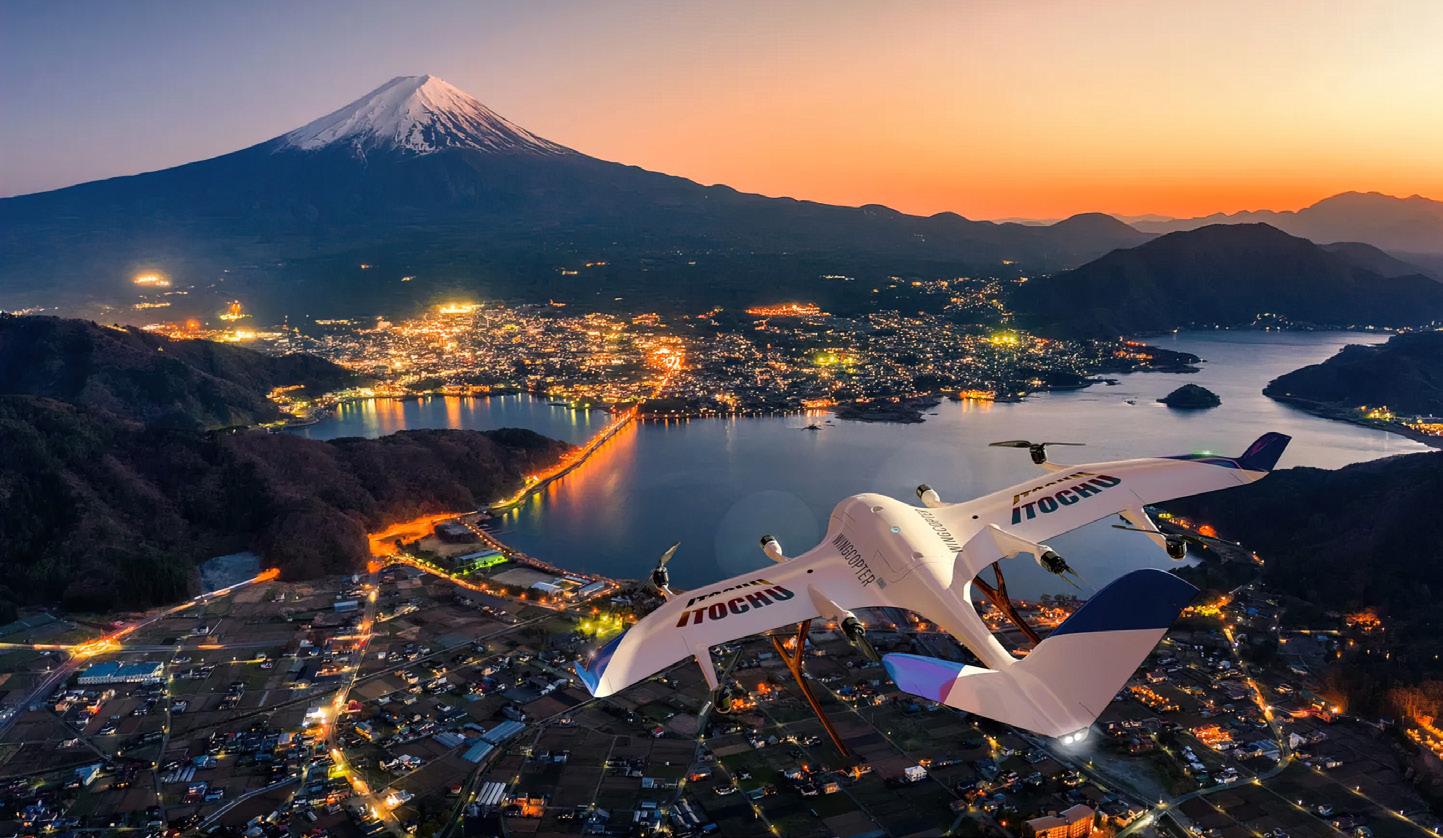

Once successful, Wingcopter will be granted permission to conduct flights equivalent to Level 4. This refers to Beyond Visual Line of Sight (BVLOS) in populated areas, significantly expanding the application range of delivery drones.
This makes Wingcopter and its partner ITOCHU one of the first to set up commercial BVLOS operations in Japan. With its aging population and remote landscapes, including many inhabited islands, the country is considered one of the world’s primary markets for drone delivery.
Florian-Michael Adolf, Head of Certification at Wingcopter, remarked, “This represents significant progress for commercial drone delivery in Japan and beyond. We are striving for type certification, as it underscores our commitment to safety and the professionalism of our team.”
Masaharu Sato, Deputy General Manager, Aerospace Department at ITOCHU, added, “We
see great potential in Wingcopter’s delivery drone to make everybody’s life better. It is our honour to collaborate with its dedicated professionals, led by the management team. We look forward to continuing this exciting journey together.”
The release continues, “The partners aim to use the Wingcopter 198 to establish drone delivery networks and services that can provide an air bridge to overcome various social challenges by transporting vital and urgently needed goods quickly and environmentally friendly over many kilometres and above challenging terrain.”
ITOCHU, a long-time business partner and investor in Wingcopter, who hold extensive knowledge, networks and resources in Japan, will conduct several Proof of Concepts under special permits until the expected TC is achieved.
In May last year, the collaboration successfully conducted the implementation of medical blood product transportation by Wingcopter’s delivery drones, the first of its kind in Japan.
In addition to the TC efforts in Japan, Wingcopter is currently undergoing the FAA type certification process in the U.S, which will also unlock the huge commercial potential of the North American market.

Source: SAF Investor
Author: Fayaz Hussain
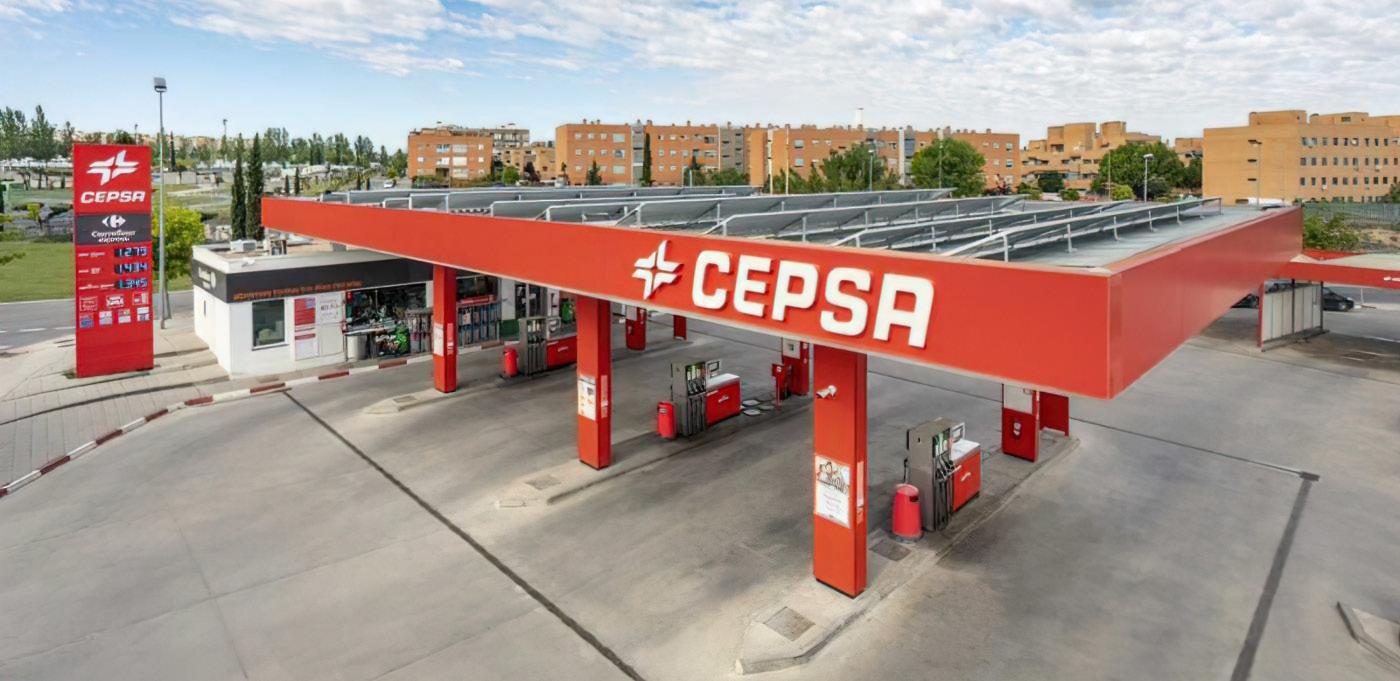
Spanish multinational oil and gas company Cepsa has successfully raised €750m from bond issue to bolster production of 2G biofuels including sustainable aviation fuel, HVO and hydrogen.
This is the largest-ever bond issuance by Cepsa well above previous issues. The issue closed with an annual coupon of 4.125% and maturity in April 2031.
“The success of this bond issue reflects the support from the investment community for Cepsa’s transformation strategy and their confidence in our business prospects for the coming years. This transaction diversifies our sources of financing and strengthens our liquidity position, allowing us to comfortably meet our debt commitments and investment plans,” said Carmen de Pablo, CFO, Cepsa.
The company is planning to use the funds to support its recently-launched Positive Motion strategy to become a European leader in the production of 2G biofuels and green hydrogen, and the deployment

of a network of ultra-fast electric chargers.
Under its 2030 Positive Motion strategy, Cepsa is planning to become the leading biofuels producer in Spain and Portugal. The company is targeting 0.8m tons of SAF production per by year by 2030 –equivalent to meet one-third of the demand likely to come from European regulations put in place.
Overall, the company is planning to produce 2.5m tons of 2G biofuels by 2030.
The company already has 35% share of the Spain’s aviation market with standing partnerships with major airlines including Iberia.
Beyond biofuels, the company also has plans to lead the green hydrogen production in Spain and Portugal with projects to set up 2GW equivalent capacity by 2030.
Cepsa was recently reaffirmed by S&P and Fitch with an investment grade rating (BBB-) and stable outlook.
Source: SAF Investor
Author: Fayaz Hussain
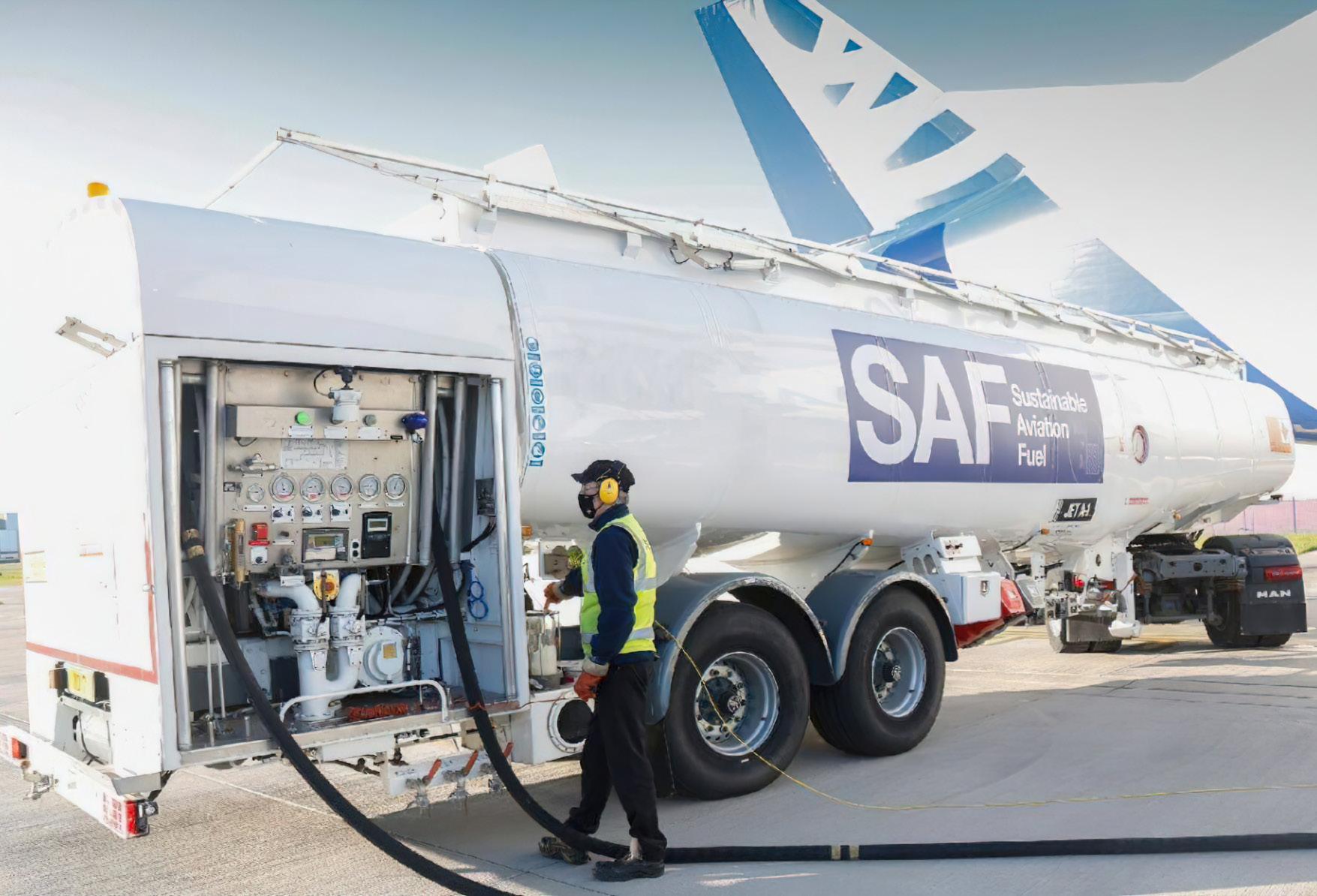
JohnsonMatthey and bp said that DG Fuels has chosen their co-developed Fischer Tropsch (FT) CANS™ technology for its first sustainable aviation fuel (SAF) plant in Louisiana, USA.
“We are extremely excited to be moving forward with Johnson Matthey to execute our unique strategy of high carbon conversion. With this technology, we will create a product that is responsibly made and can be immediately substituted for conventional aviation fuel with no engine adaptations,” said Christopher J. Chaput, President, DG Fuels.
DG Fuels proposed $4bn project in St. James Parish, Louisiana, USA, will use FT technology and is the largest announced non-HEFA-based SAF facility in the world.
The plant is designed to only produce SAF, with a planned capacity of 13,000 bpd (600,000MT per annum).

DG Fuels is planning 10 more SAF production plants across the US, modelled on the Louisiana plant with JM and bp.
“The size of this project is truly exciting and would help take the industry closer to wide-scale use of SAF … Our FT CANS technology enables costeffective deployment across a wide range of project sizes,” said Maurits van Tol, CEO, Johnson Matthey.
DG Fuels Louisiana plant is expected to begin production by 2028.
The producer has already secured offtake agreements with major airlines, including multiyear deals with both Air France-KLM and Delta Air Lines.
DG Fuels also has a strategic partnership with Airbus to help make SAF available at scale around the world.
Source: SAF Investor
Author: Fayaz Hussain
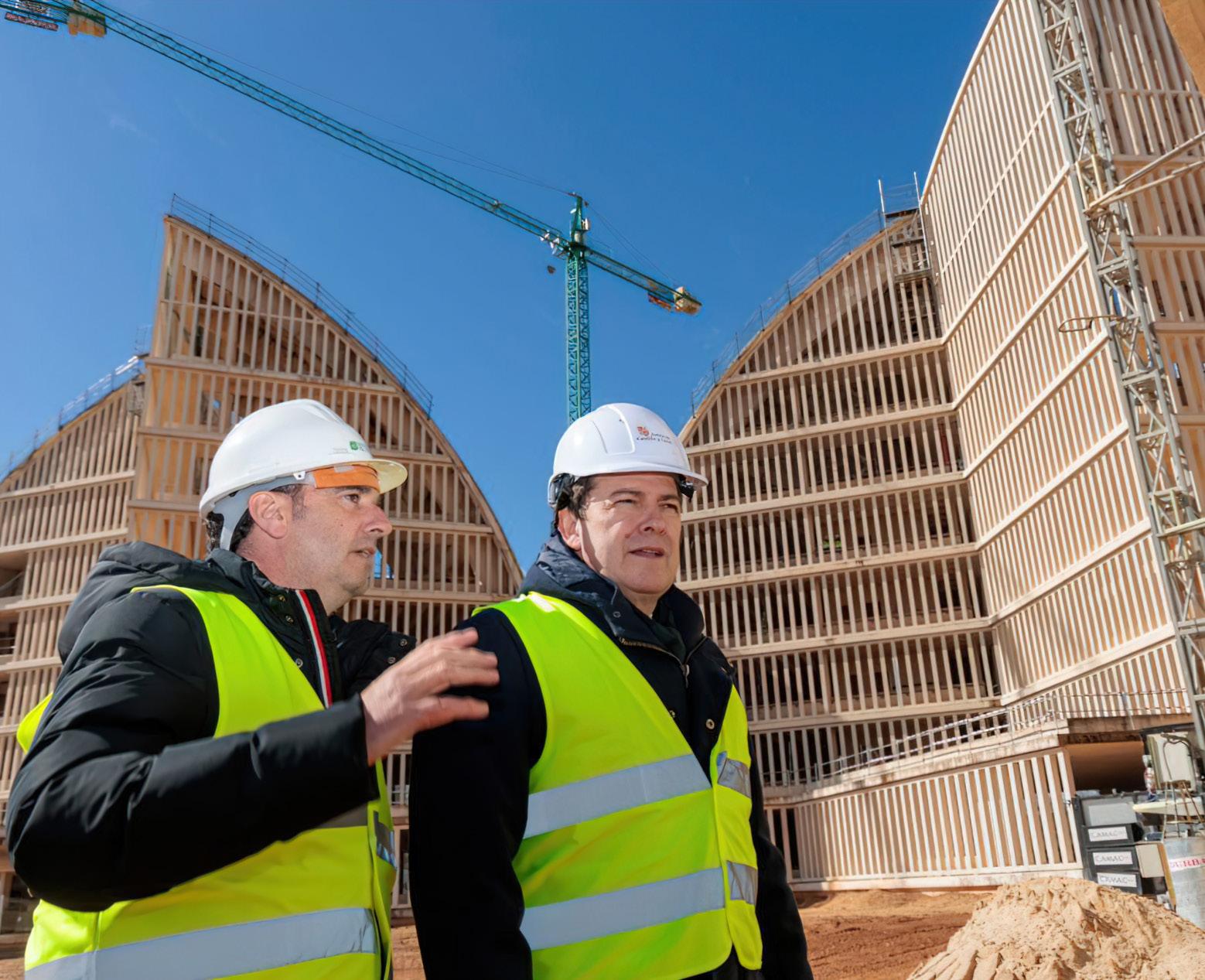
Madrid-based renewable energy firm Solarig said it will set up a sustainable aviation fuel (SAF) plant with a production capacity of 60,000 tonnes per annum in Parque Empresarial del Medio Ambiente (PEMA), Garray, Spain.
The project titled ‘Numantia SAF’ will incorporate fully dedicated renewable assets such as a 370MWp solar photovoltaic plant, a 50MW wind farm, as well as battery storage with a 100MWh capacity.
The construction phase is expected to start in 2026 and the commissioning and operation in 2028.
The plant will house two pathways for SAF including the gas-to-liquid (GtL) one, that consists of the reforming of biomethane obtained from the valorisation of local agricultural and livestock waste.
Secondly, the power-to-liquid (PtL) one that



combines biogenic CO2 with renewable H2.


The company is aiming to power both of these pathways through renewable energy and will decarbonise the transport sector through the capture and utilisation of 140,000 tonnes of CO2 per year, and the reduction of 170,000 tonnes of CO2 per year.
Solarig has signed an agreement with the Sociedad Pública de Infraestructuras y Medio Ambiente de Castilla y León (Somacyl) to acquire 116,000 square metres within PEMA, where the plant will be located.
“Today Solarig is announcing a pioneering project in the world with a fully circular approach: it involves the use and recovery of biogas produced from our agricultural and livestock waste together with renewable resources: water, wind and sun, ” said Miguel Ángel Calleja, president and CEO, Solarig.

Source: eVTOL Insights
Author: Chris Stonor
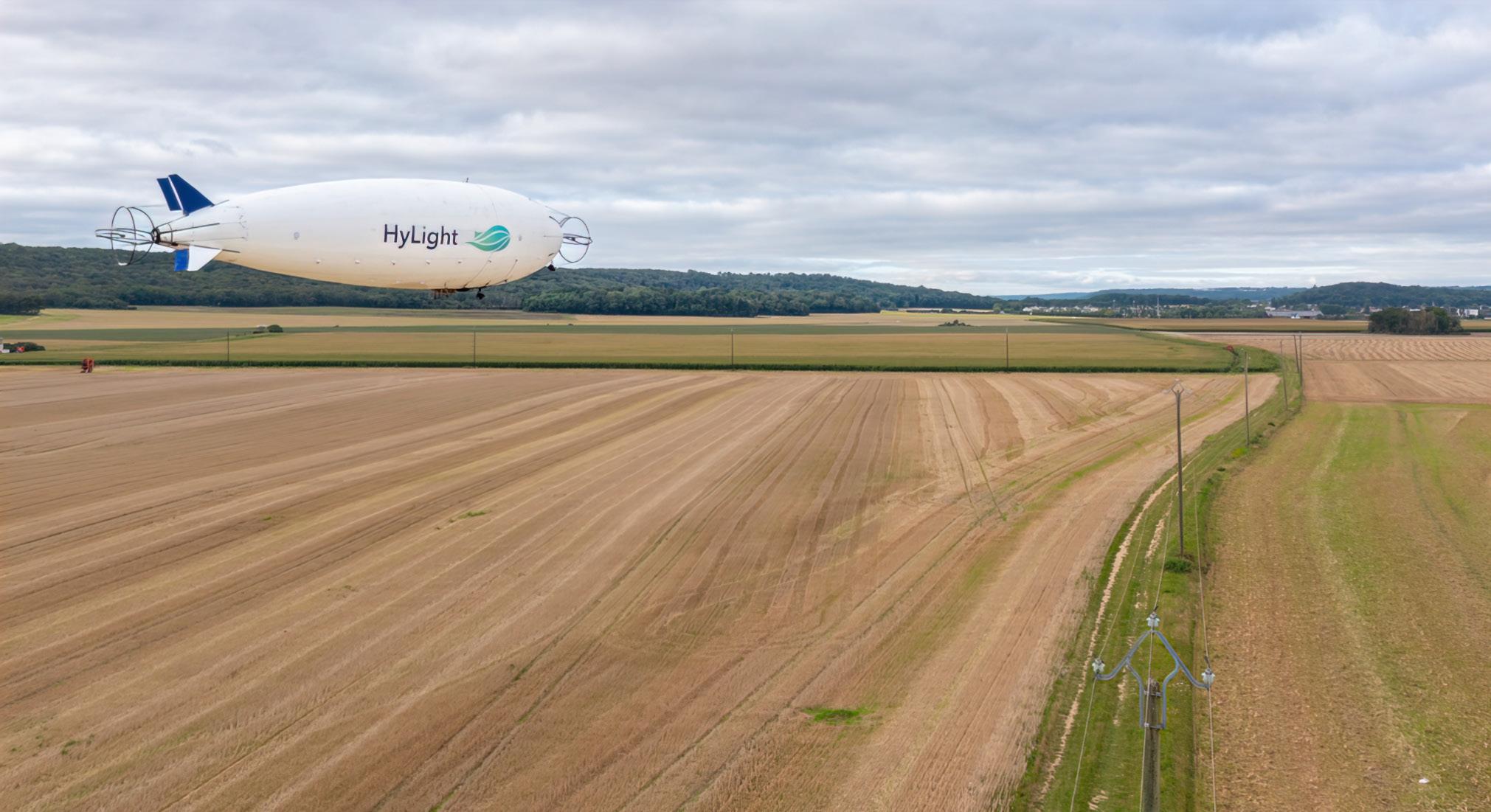
Thedays of the calamitous Hindenburg disaster is buried and forgotten as a new revolution of airships focus on the clean, green movement of atmospheric decarbonisation.
The latest in a growing roster of hopefuls is France-based company, HyLight, who announced this week a USD4 million investment for development of its hydrogenpowered airship, The HyLighter.
Marketed as “a pioneer of aerial inspection,” the company claims there is “a revolution in aerial photography underway.” Its new investors range from Y Combinator, Ring Capital and Kima Ventures to Marc Tarpenning, the co-Founder of Tesla.
This deal enables HyLight to accelerate the deployment of its airship “on an industrial scale” to offer “the first zero-emission solution” capable of inspecting any type of infrastructure from the air including power lines, gas pipelines and railway tracks.
Martin Bocken, CEO of HyLight, remarked, “This round of financing is a decisive milestone.

It allows us to realise our vision of providing large-scale infrastructure inspection in a decarbonised and highly precise manner. With the support of our investors, we are ready to redefine the standards of industrial inspection and meet growing environmental and regulatory requirements."
An obvious question: Surely, drones can do the same job, more easily, faster and at less cost? And drones are “decarbonised” too.
Meanwhile, HyLight points out in its press release that infrastructure monitoring “is a costly and complex matter.” It states, “There are 80 million kilometres of energy infrastructure on our planet. That is 200 times the distance between the Earth and the Moon. These power lines and pipelines are critical infrastructure for the proper functioning of societies. Therefore, they must be inspected at regular intervals (sometimes several times per month) to ensure their good condition and prevent failures.” Adding, “However, today, infrastructure operators struggle to conduct accurate, large-scale inspections.”
“As a result,” the release continues, “methane leaks from oil and gas infrastructure represent 4 percent of global greenhouse gas emissions and result in annual losses of USD7 billion in the European and North American markets. The costs of power outages amount to USD18 billion per year in the USA alone.” It then points out, “However, the regulatory framework is tightening, requiring operators to accelerate inspections. But effectively identifying small faults in such large areas is like looking for a needle in a haystack!”
The company reckons the airship can drastically reduce inspection costs and enables ultraprecise data to be collected over large areas, all without emitting greenhouse gases.
Describing its craft as “a cross between a drone and airship”, it is easy to control and transport and, can fly for up to 10 hours, over a distance of 350 km. Its flight speed of 35 km/h, HD cameras and sensors (LIDAR, thermal, infrared, etc.) ensure optimal precision for any type of mission.
Apart from a longer flight duration, very similar to a drone… then.
The company piles on the marketing-speak, saying it has recently joined the SkyDeck accelerator at the University of California, Berkeley, as well as leading French accelerators such as Wilco, Agoranov, the Propulse program run by the French Transport Innovation Agency and the EDHEC network via Générations, the seed fund of Ring Capital and EDHEC.
HyLight also benefits from the support of high-level mentors and investors such as Tesla
co-founder Marc Tarpenning and the former SpaceX launch director, Abhishek Tripathi. Furthermore, the start-up has implemented a project with Enedis, Europe’s largest power line operator. HyLight is also a France 2030 winner, supported by the IDF region.
The USD4 million investment enables the company to achieve three crucial milestones.
• To carry out its first large-scale operations.
• Offer resources to recruit new experts in various fields including aviation regulation, embedded systems, hydrogen systems, mechanical engineering, industrialisation and software development.
• To develop new improved versions of its airship, making it even safer, more efficient and easier to produce on a large scale.
Myriam Maestroni, President and Founder of e5t, one of HyLight’s new investors, remarked, “This innovative technology provides a decarbonised and efficient solution to meet the growing needs of the energy, transportation and infrastructure sectors. We are confident that HyLight is well positioned to become a global leader in this rapidly expanding field.”
The company also hopes its airship can be deployed in other sectors including forestry, changes in sea level and water stress effecting farmland. In a nutshell, help observe and understand climate change.
For more information https://www.hylight.aero/
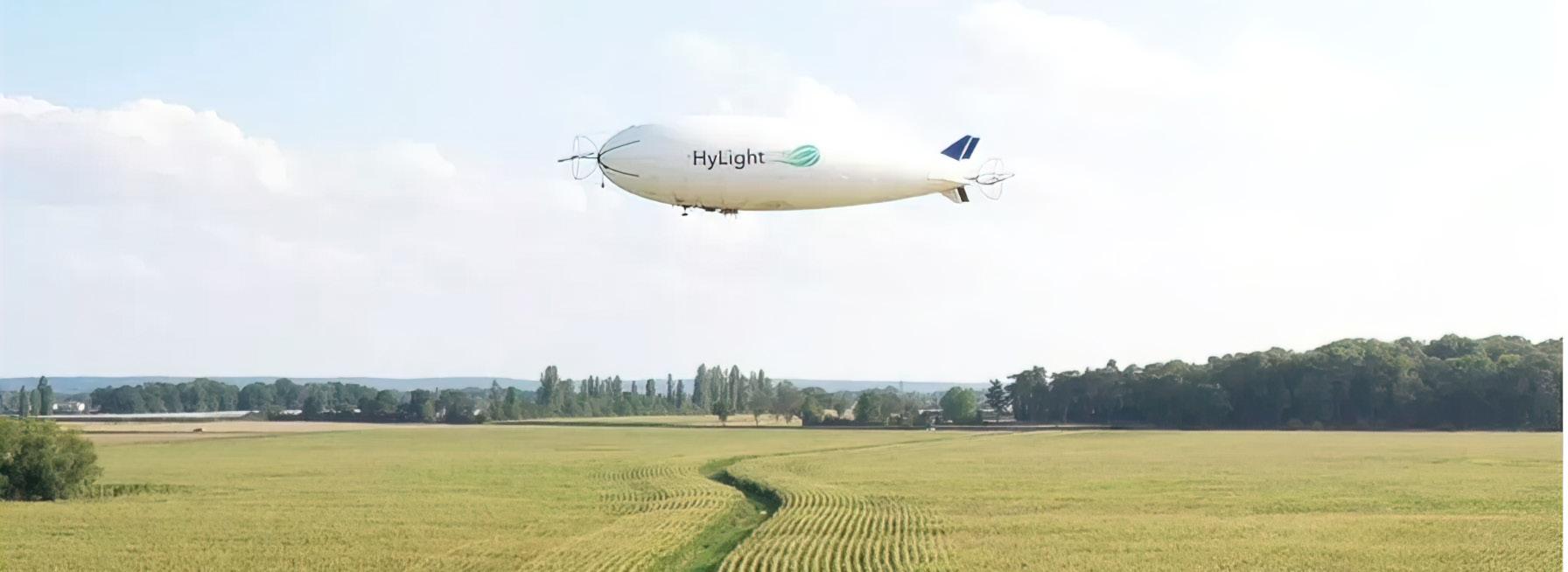
Source: SAF Investor
Author: Fayaz Hussain
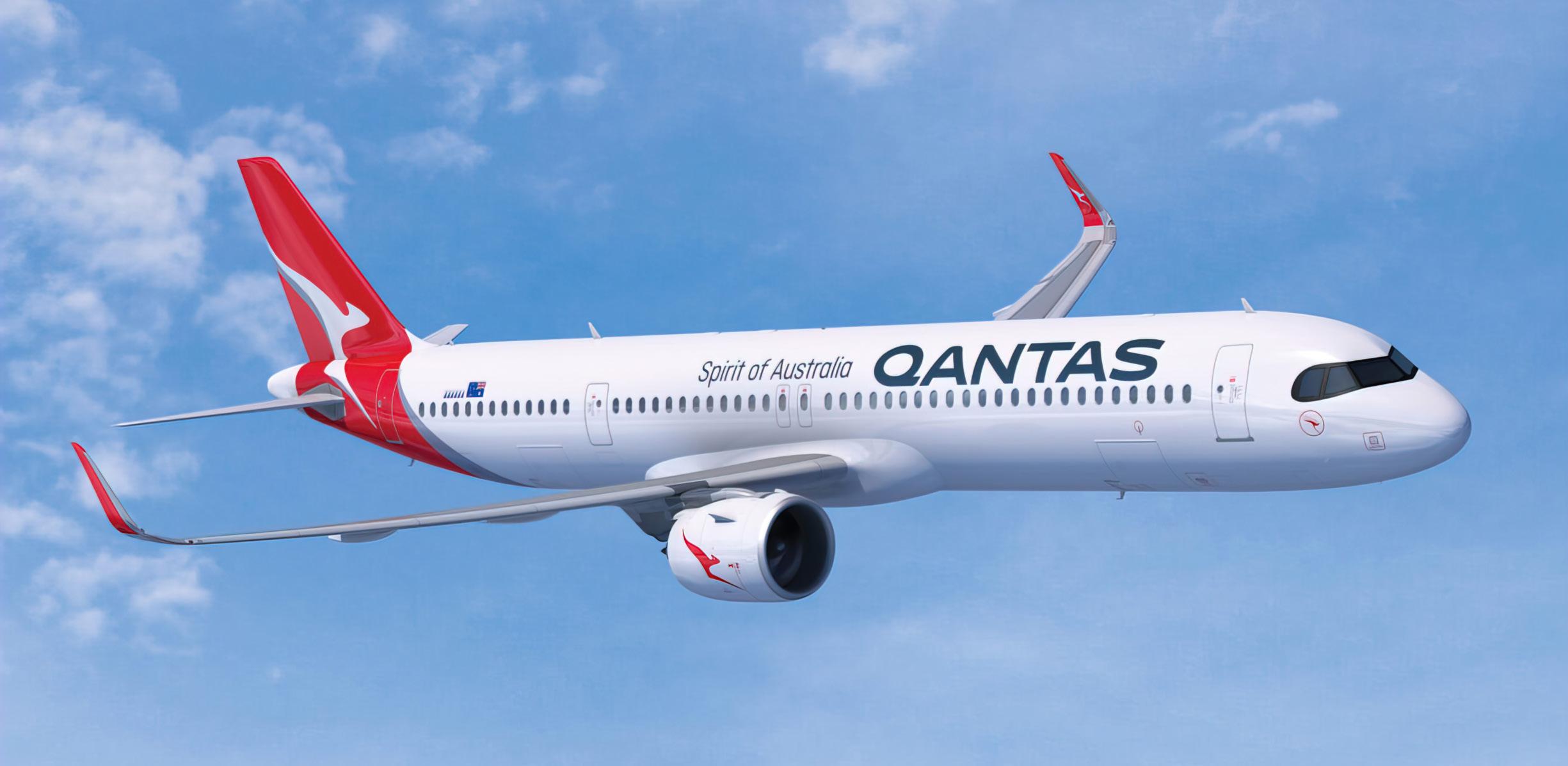
Qantassaid that number of corporates in its SAF Coalition Program has doubled from five to eleven as Australian firms continue to turn towards sustainable aviation fuel (SAF) to help decarbonise their business travel and meet emissions reductions targets.
“The growing demand from corporate Australia for SAF is a clear vote of confidence in the domestic production of biofuels,” said Andrew Parker, chief sustainability officer, Qantas.
“Our corporate program is one of the many levers we’re exploring to manage the higher cost of SAF while we continue to advocate for and invest in local production. We’re also working with industry partners to invest in local technologies and projects that will help the sector reach its net zero targets, drive economic growth, create thousands of green jobs and secure Australia’s domestic fuel security.”
Qantas said that Accenture, Fortescue and McKinsey & Company have joined as partners to the programme, contributing to address 1,000 tonnes of carbon emissions whereas Commonwealth Bank, ING Australia, Deloitte, IMC and Raytheon Australia have joined as members, contributing to between 400-600

tonnes of carbon emissions.
It said that the addition of these members and partners means that the SAF Coalition program has doubled in its first year since launching in 2023 with five inaugural partners including Australia Post, BCG and Woodside.
The Qantas Group established a $400m climate fund to provide direct investments in sustainability projects and technologies, particularly the establishment of a domestic SAF industry.
In addition, Qantas announced in August that as part of recent aircraft deals with Boeing and Airbus it will secure access to up to 500m litres of SAF per annum that would start to flow from 2028. This has the potential to meet most of the Group’s interim SAF target for 2030.
Since 2022, Qantas has purchased SAF out of London and has contracts in place to start using it in California.
The Qantas SAF Coalition program allows corporates under a “book and claim” methodology in alignment with ScienceBased Targets Initiatives guidance.
